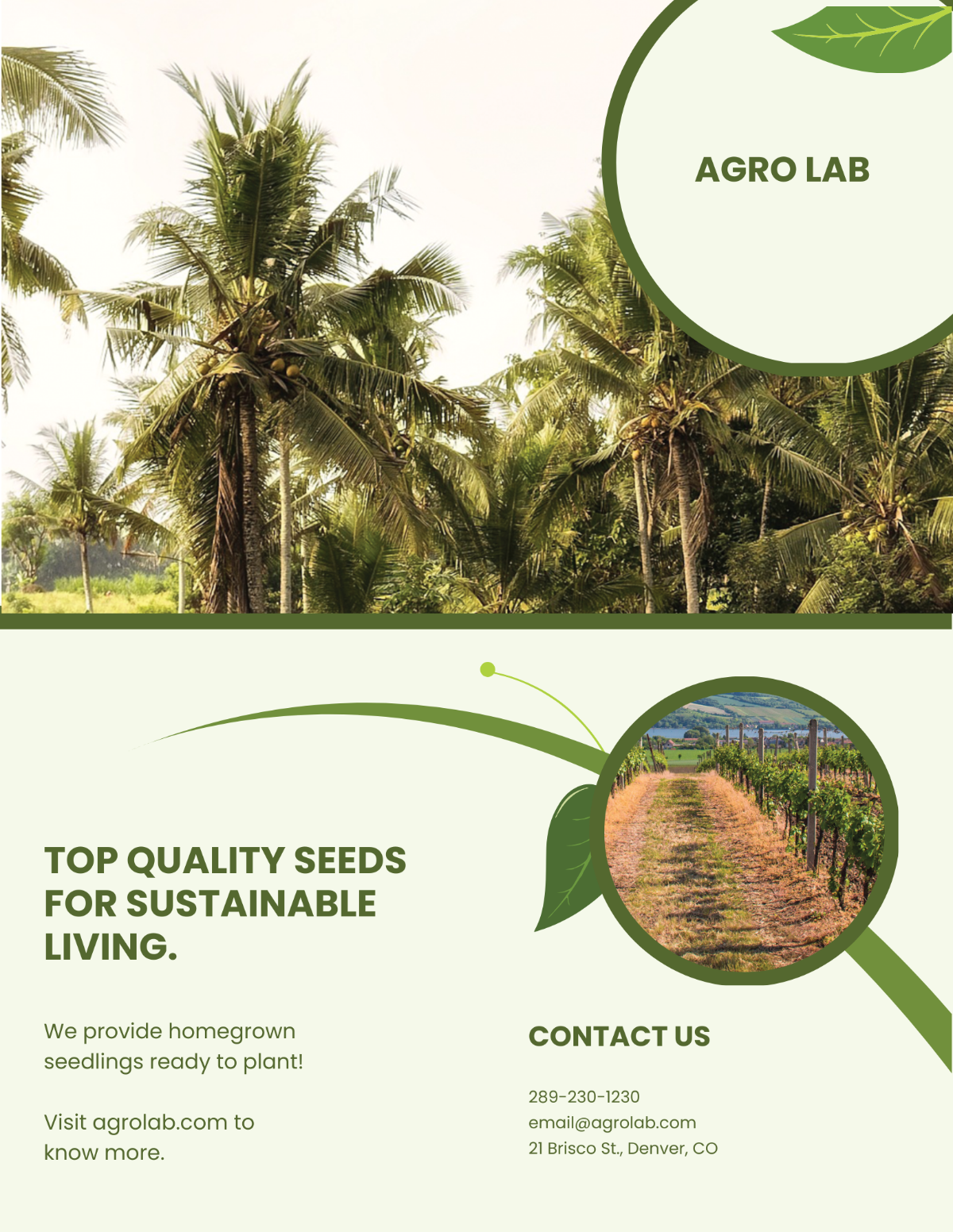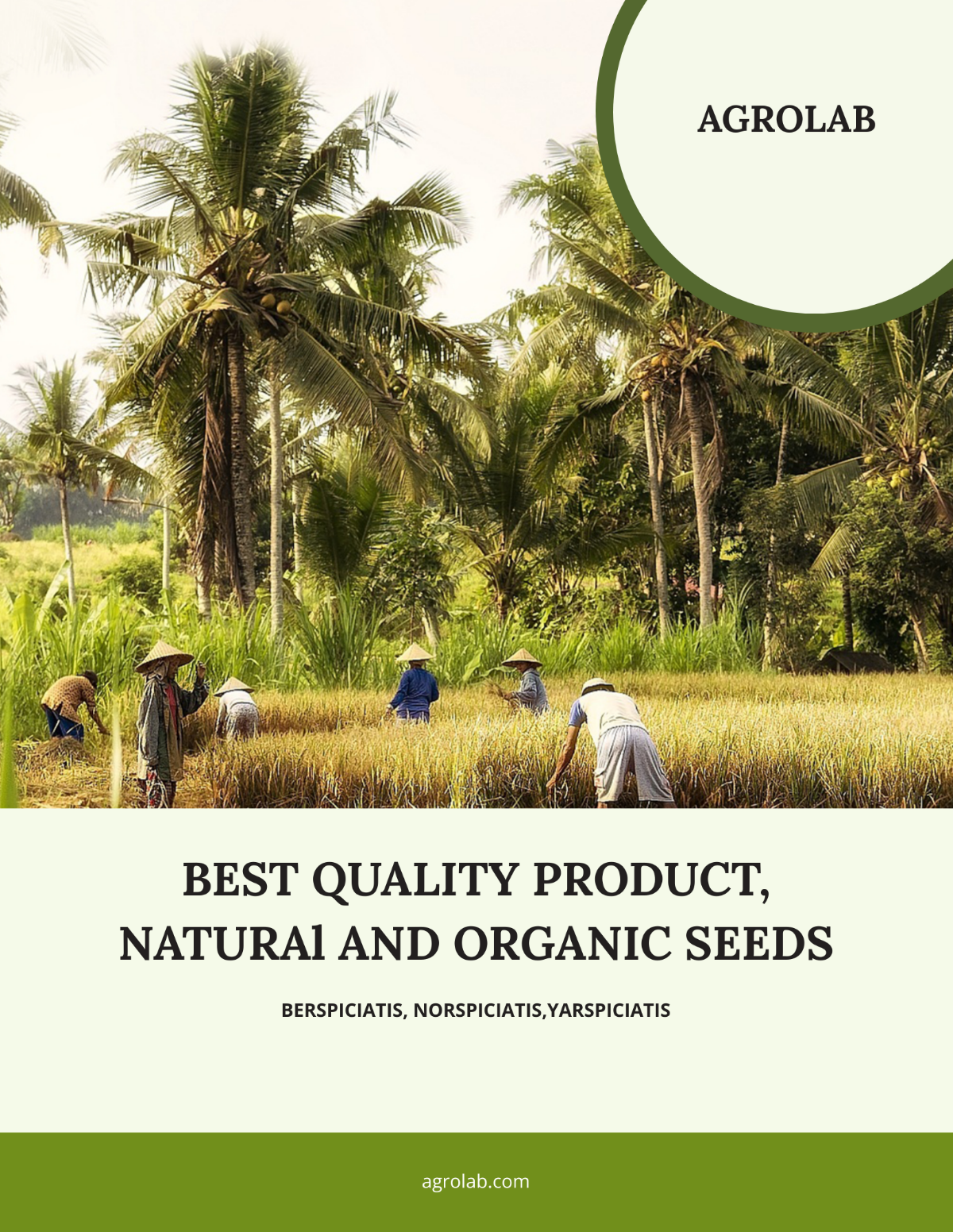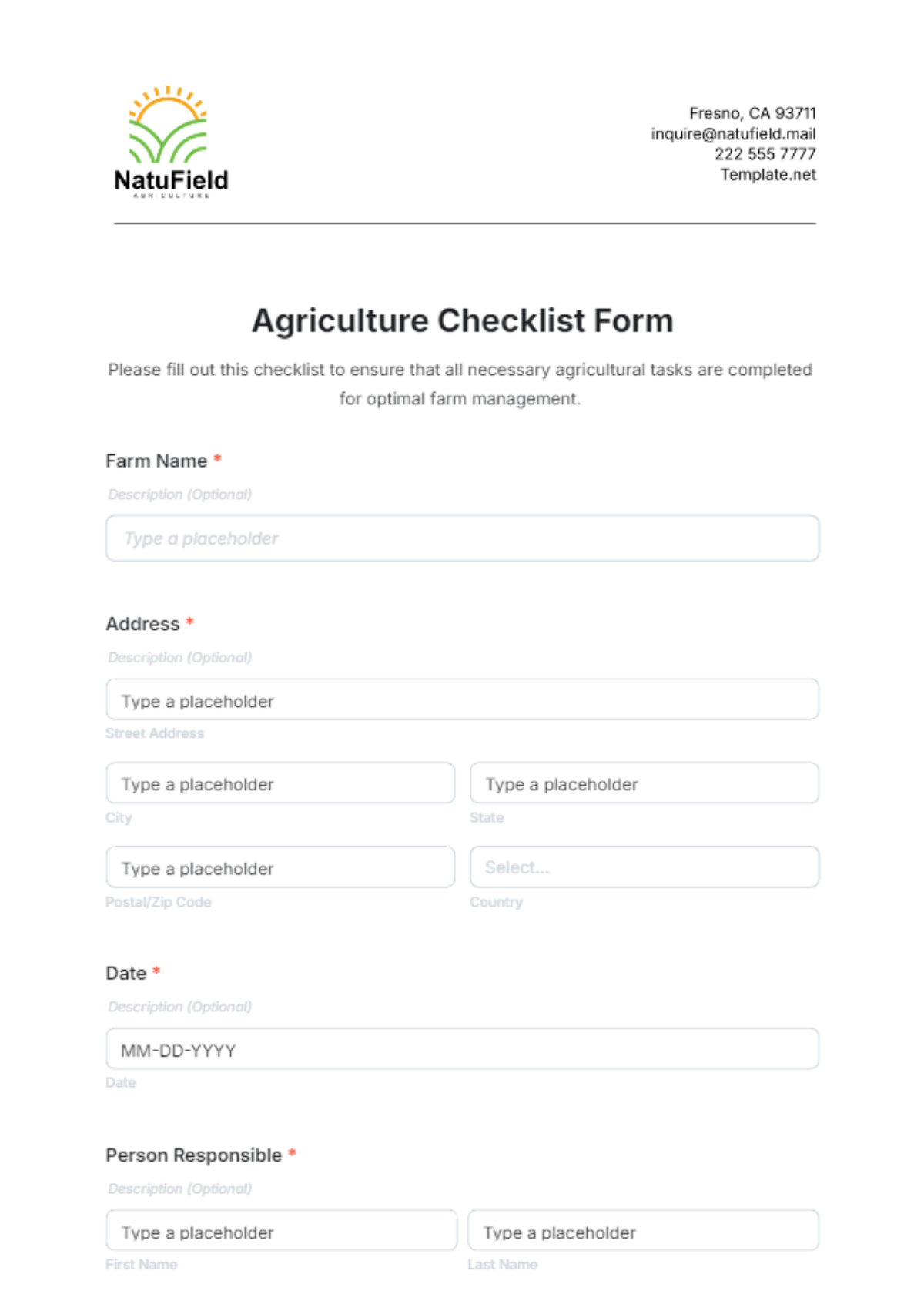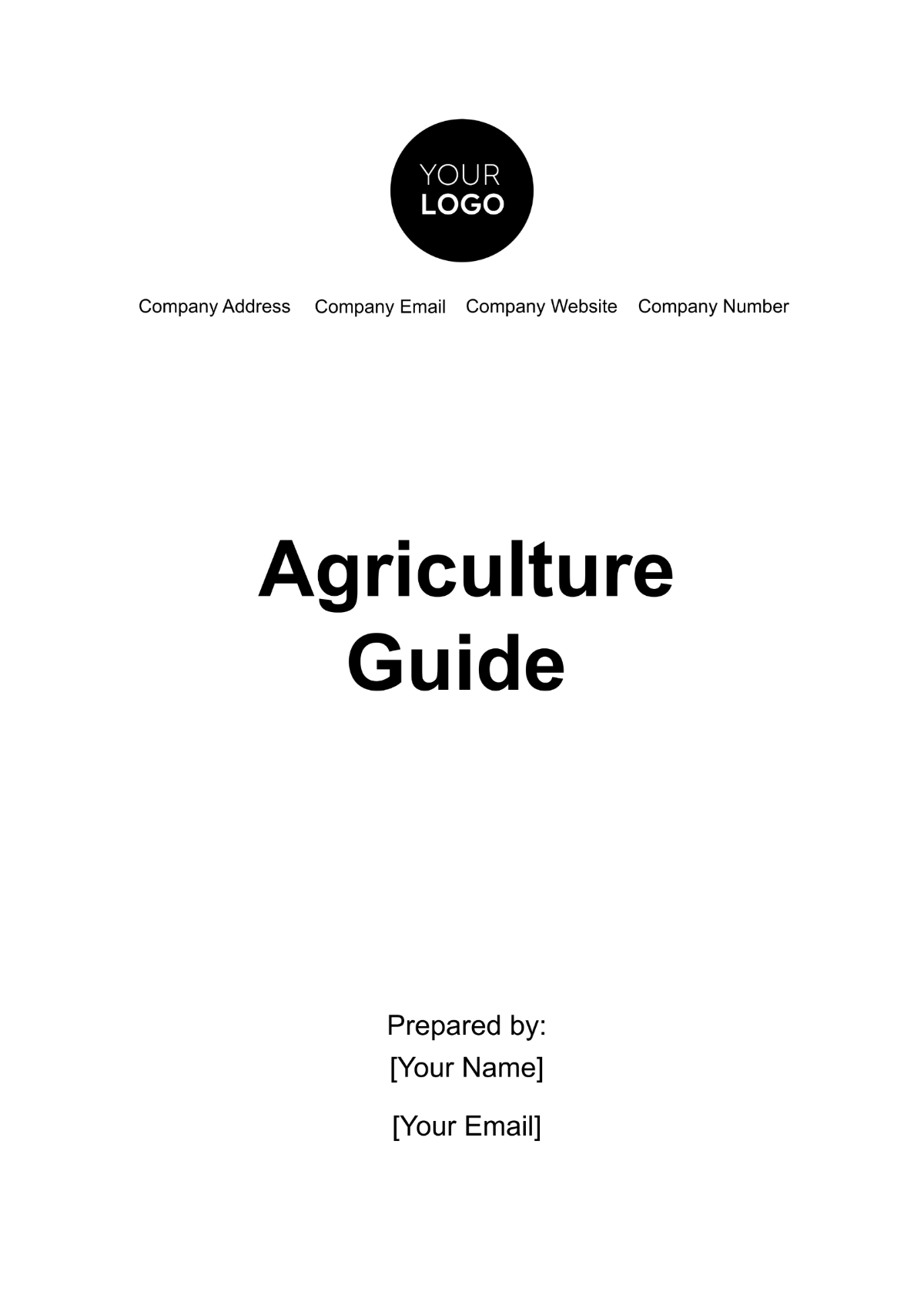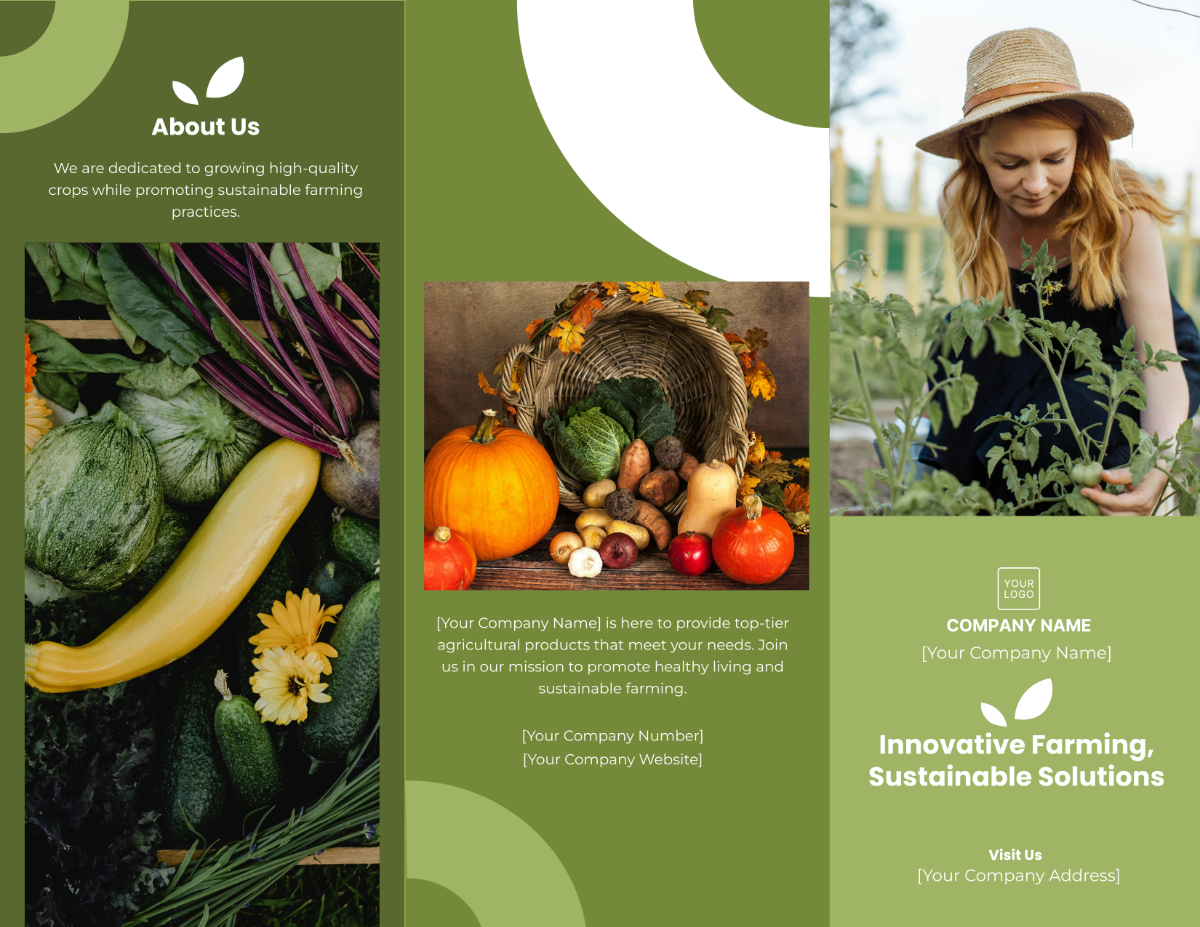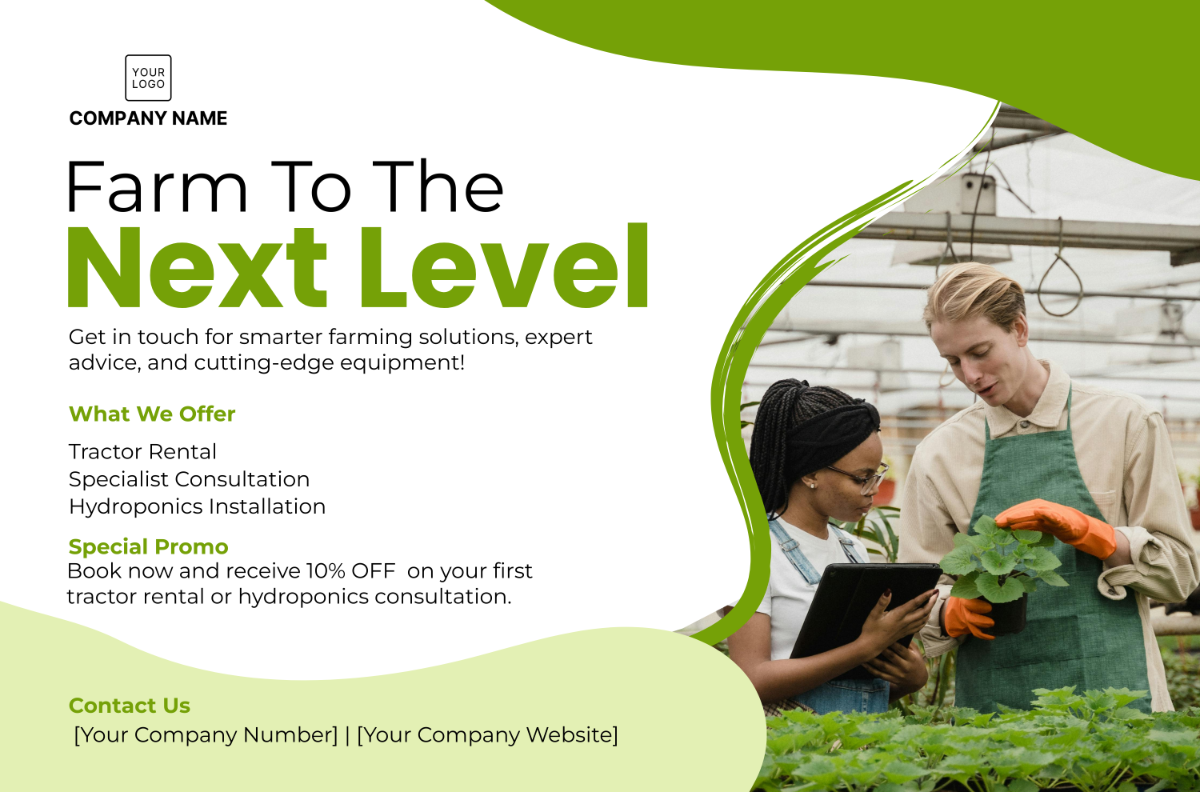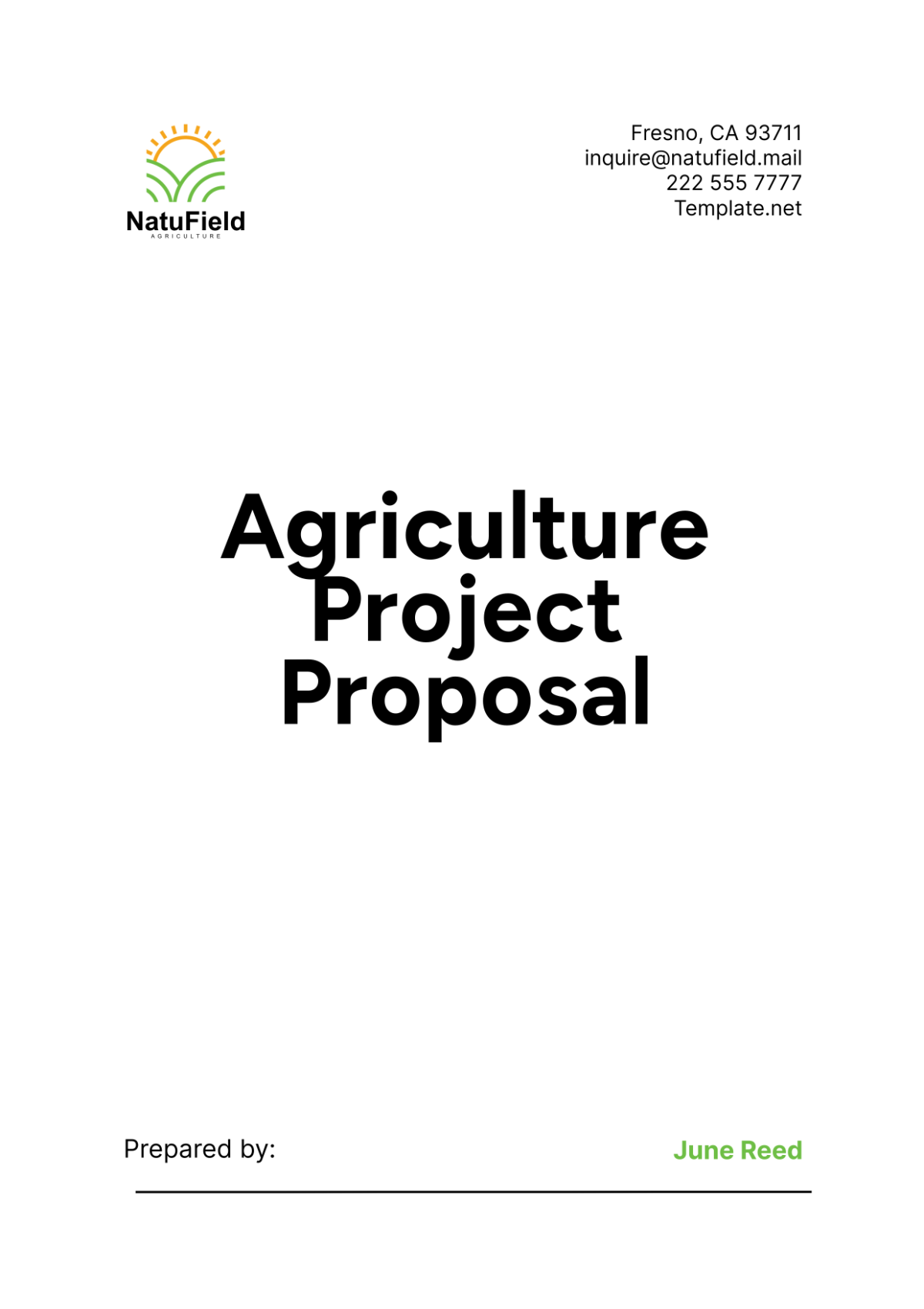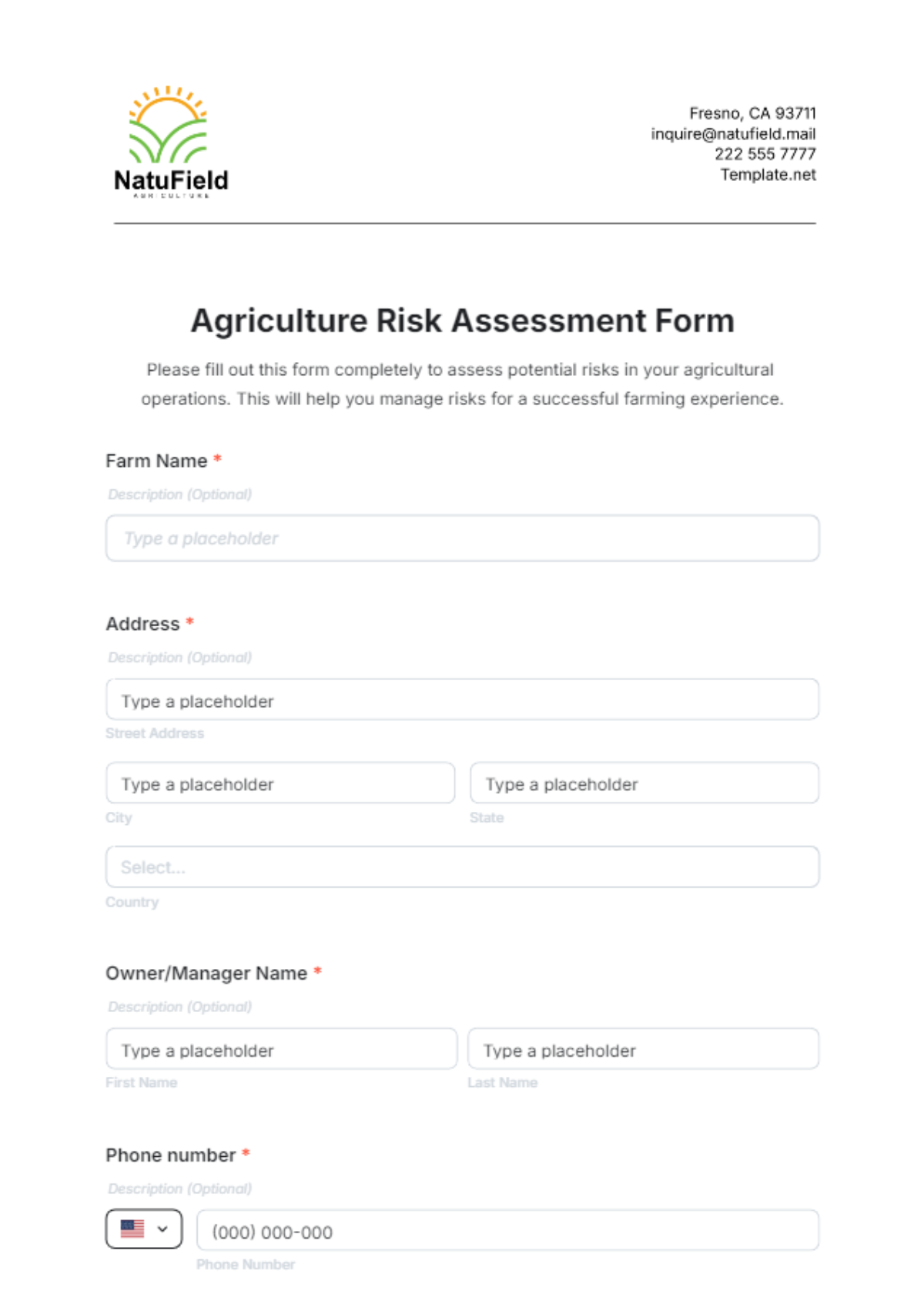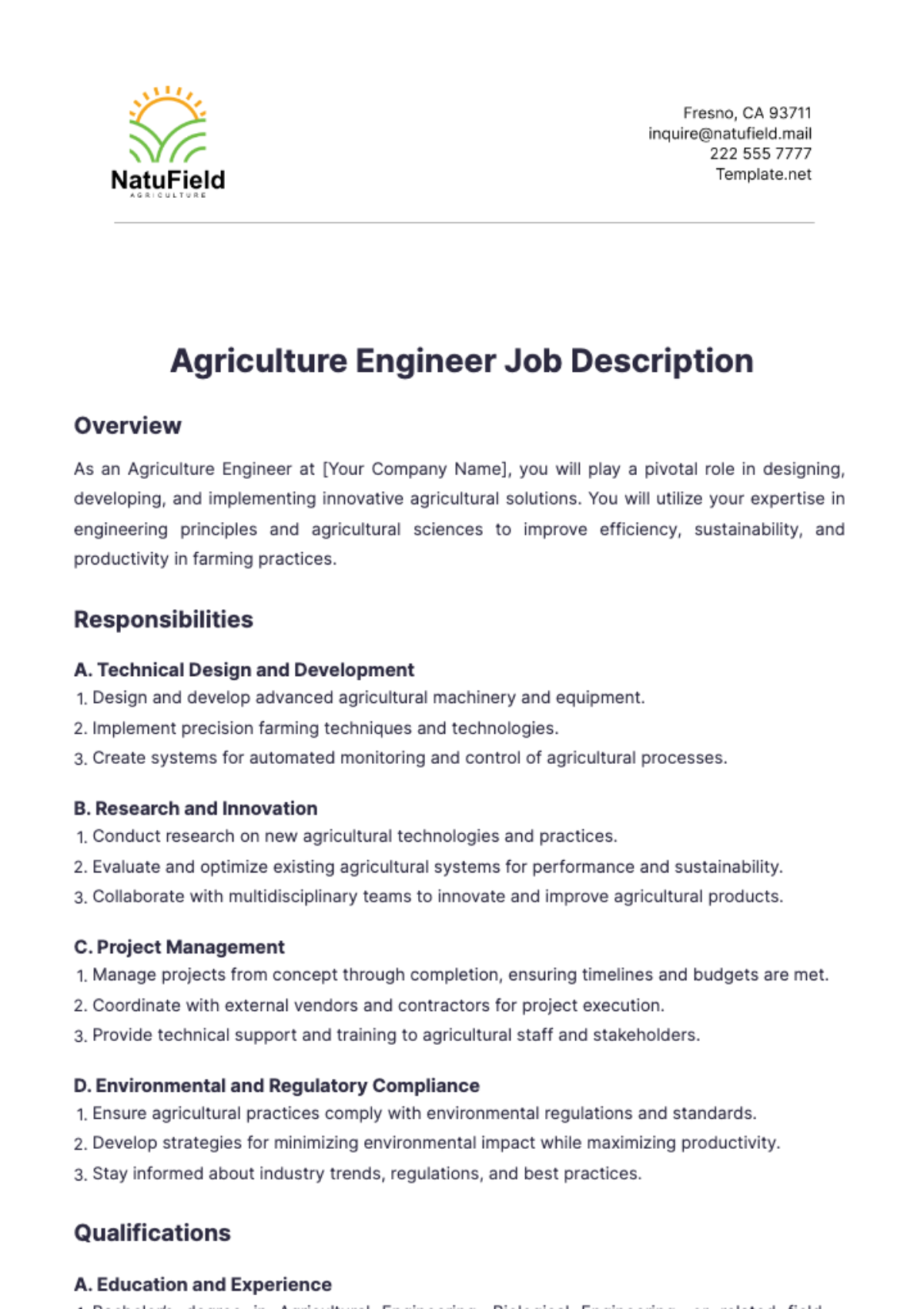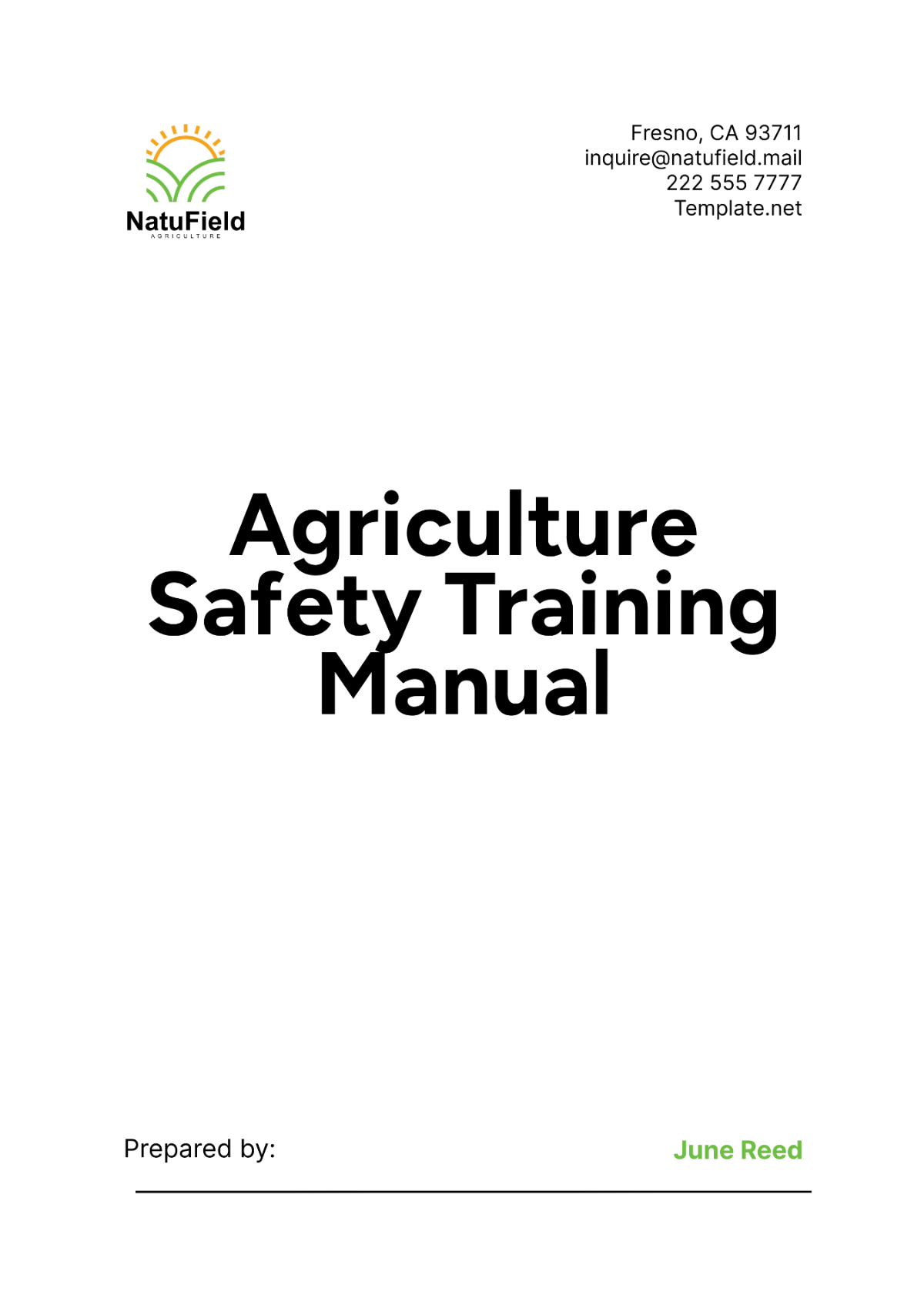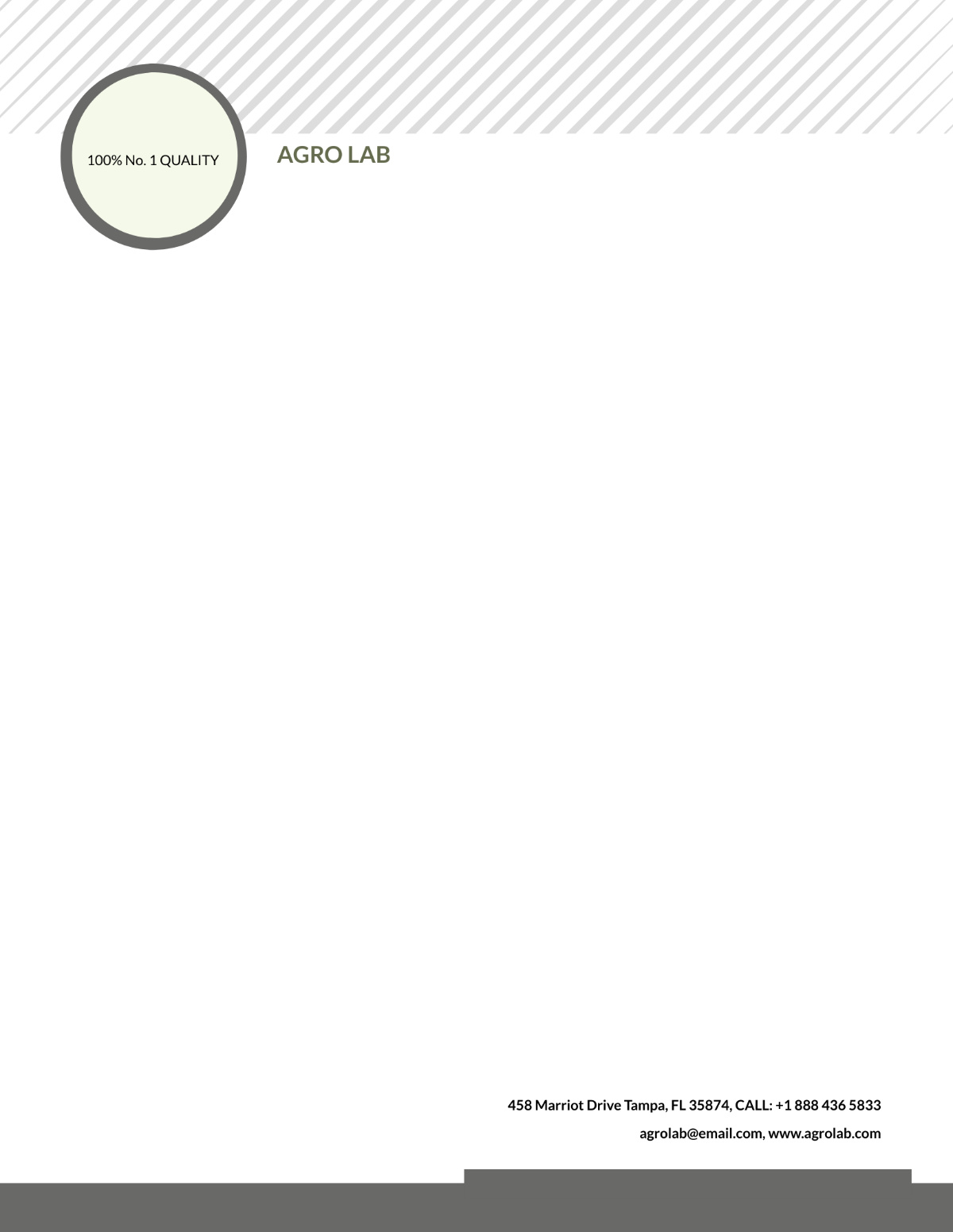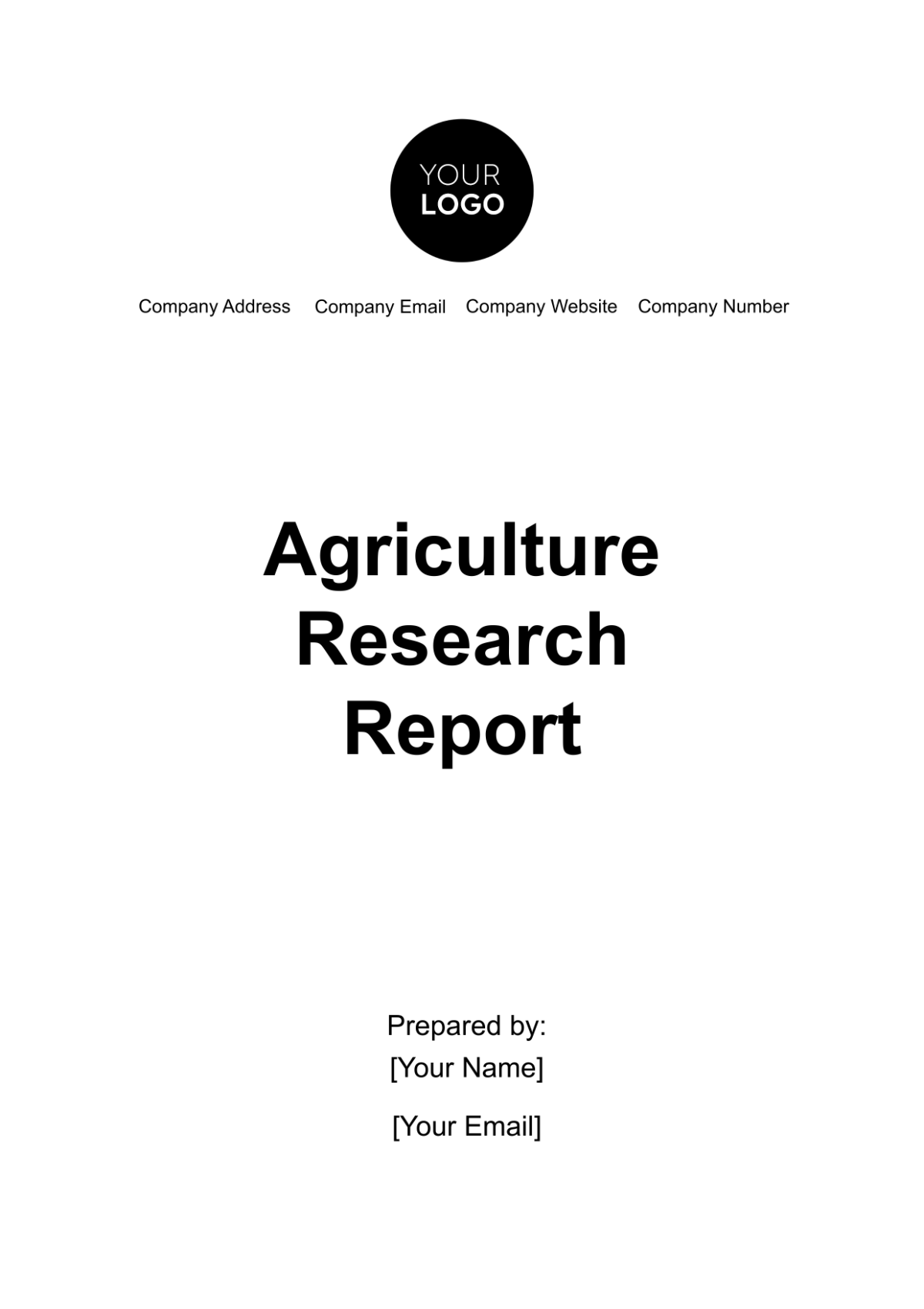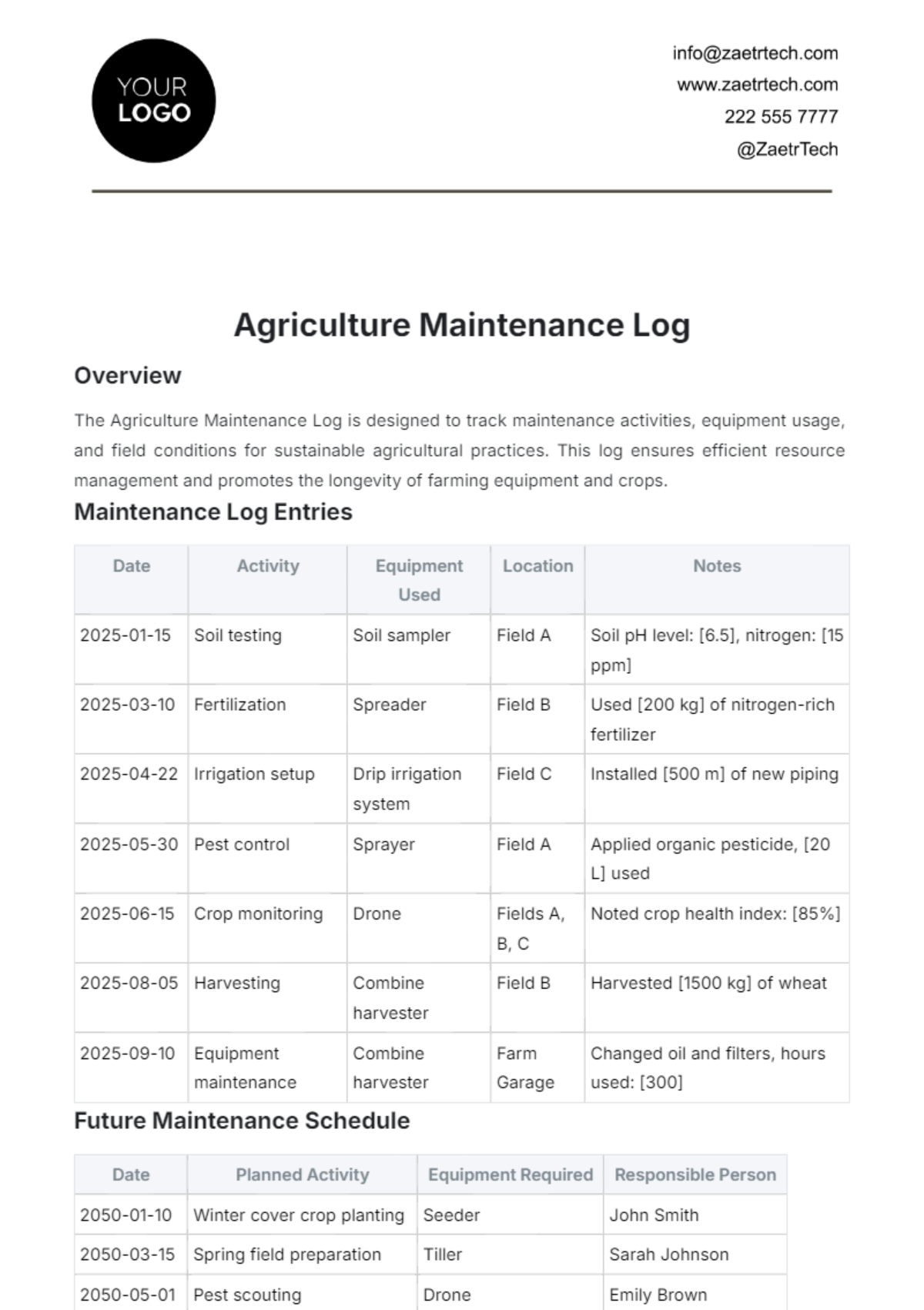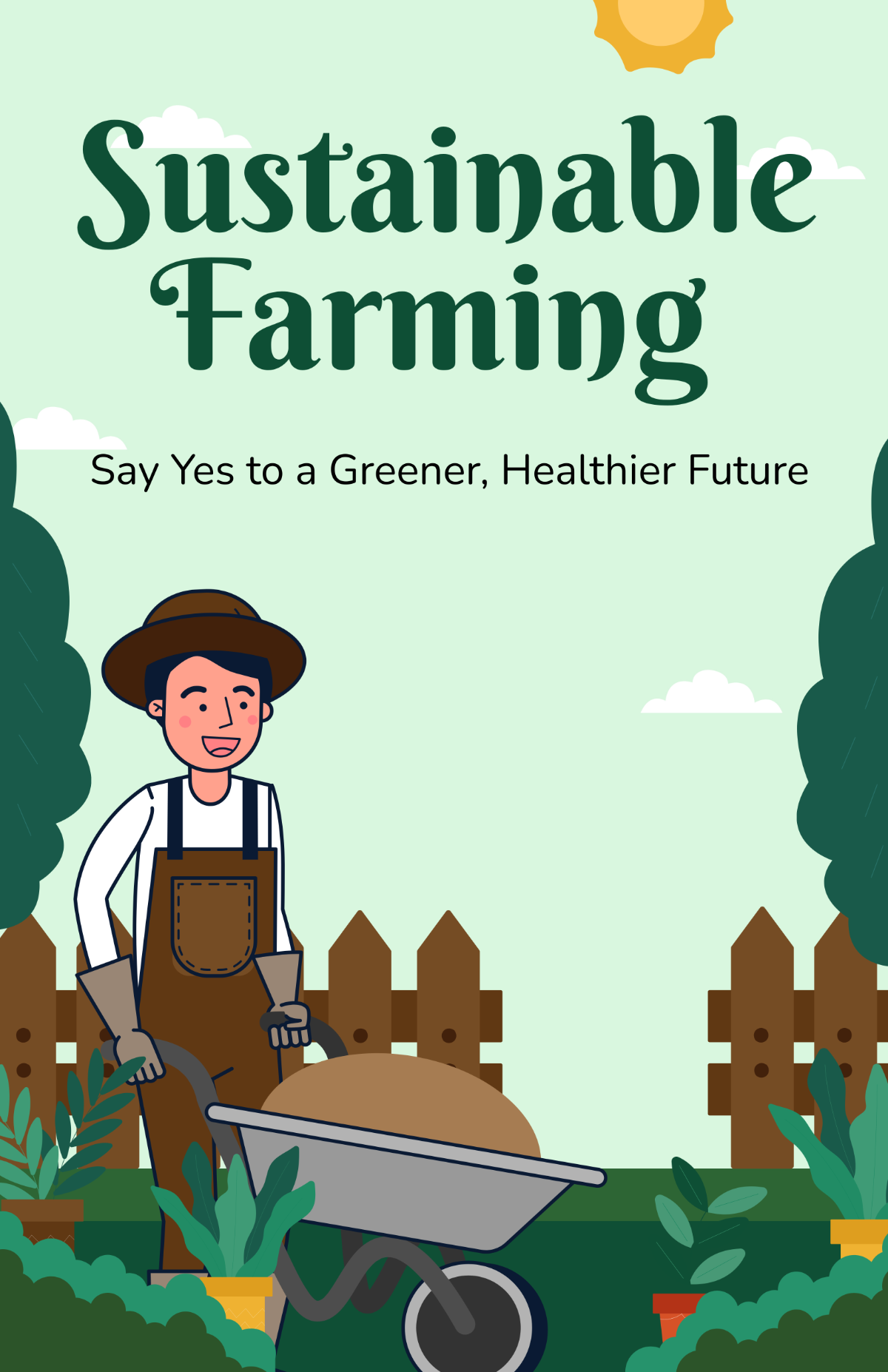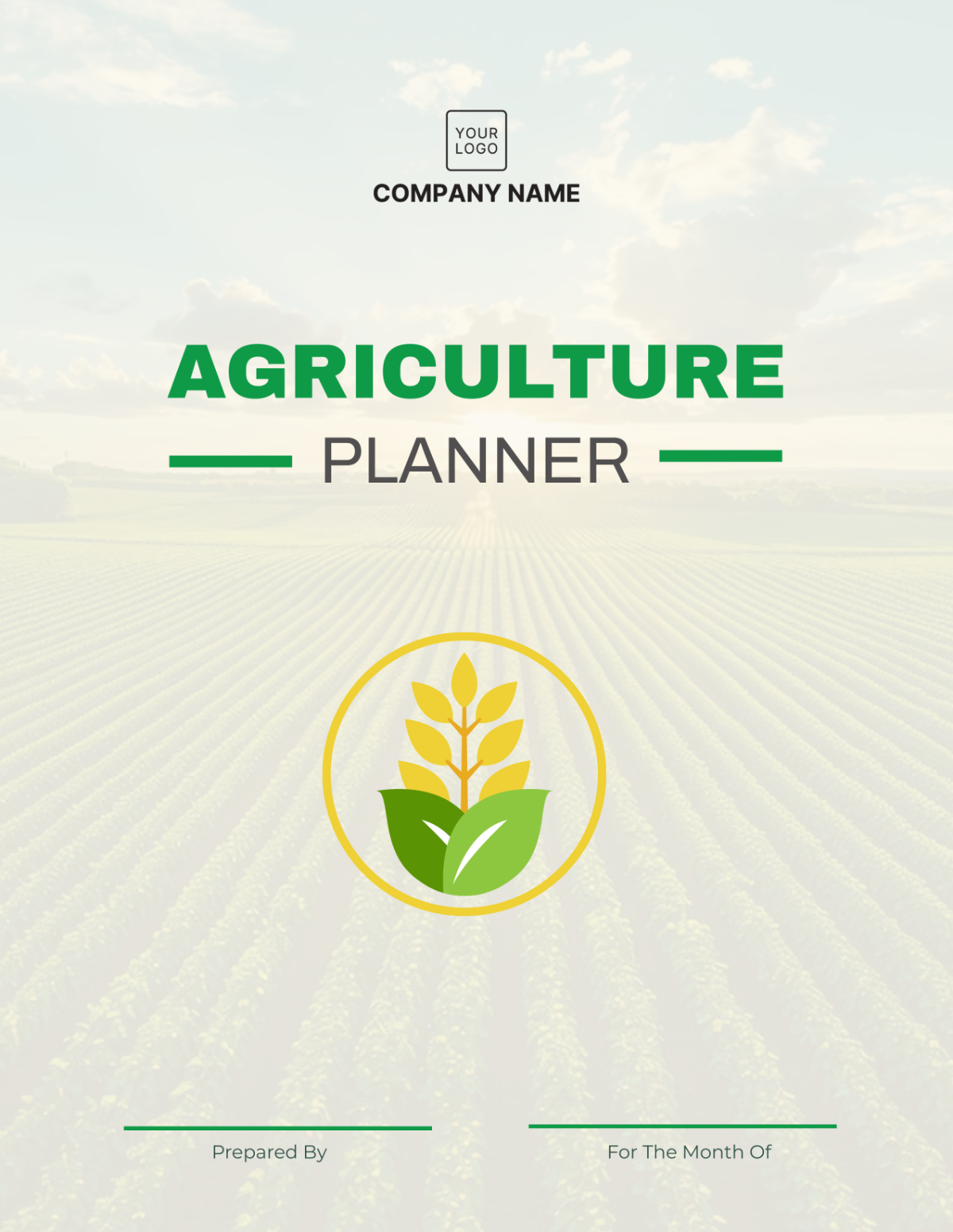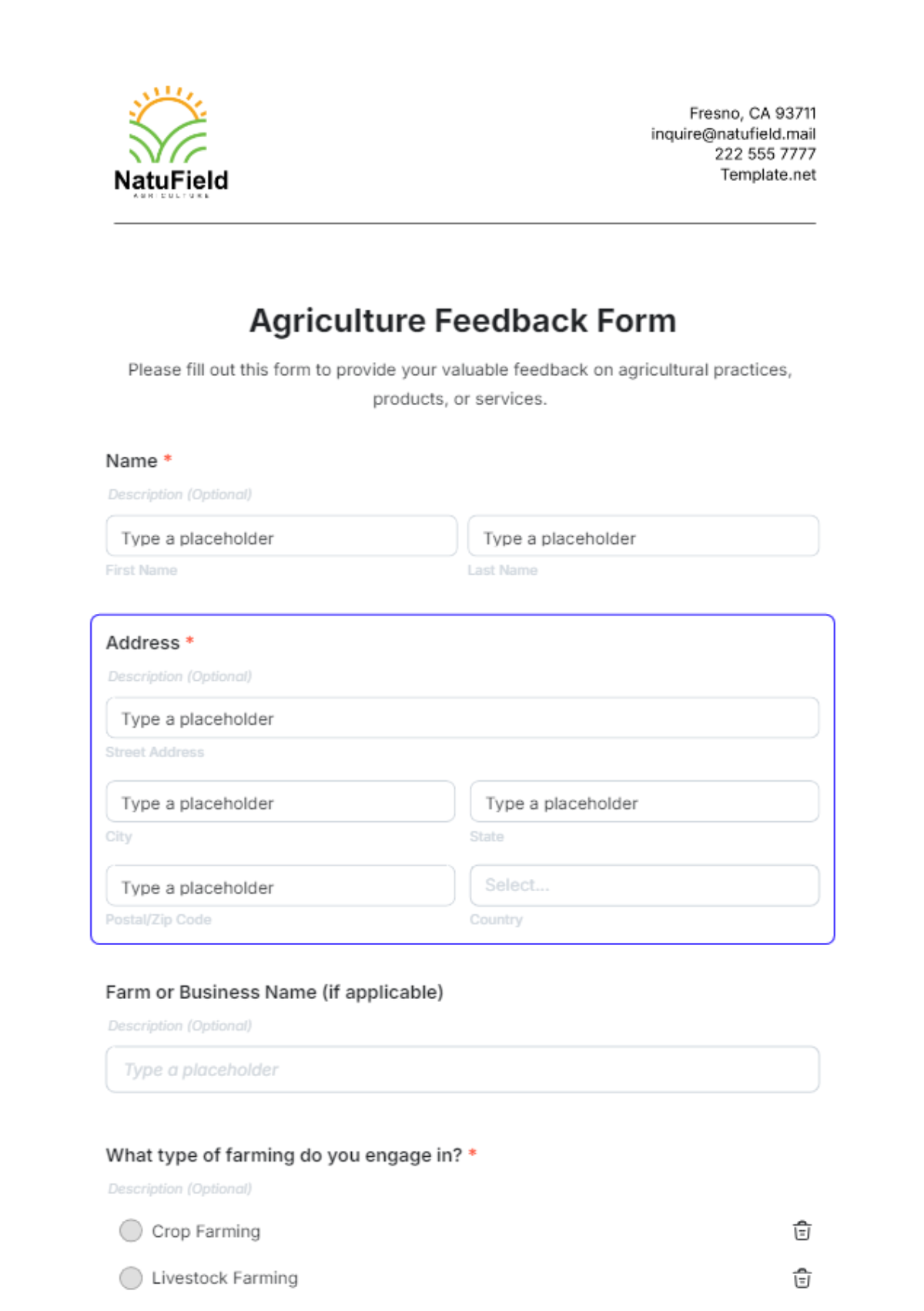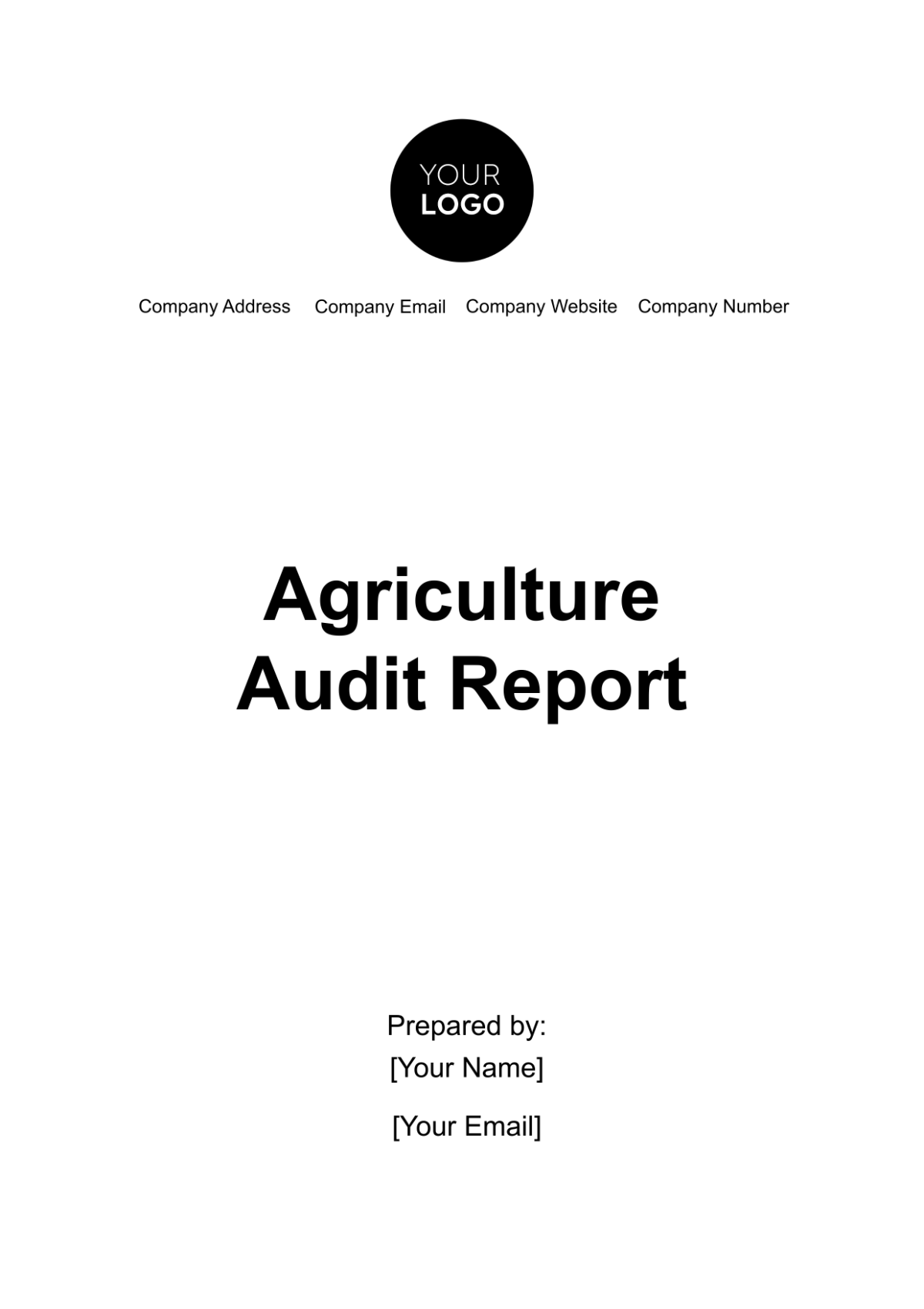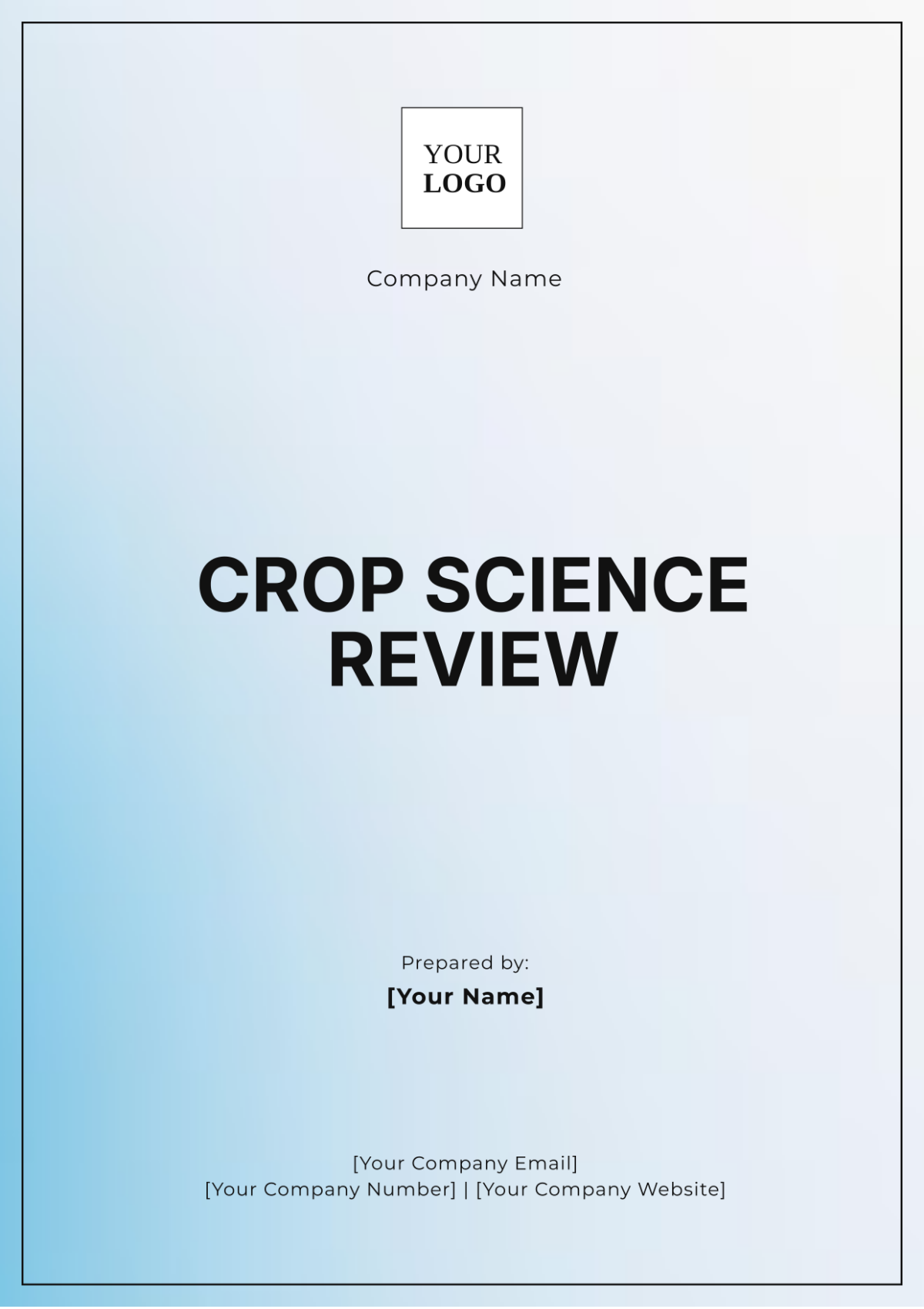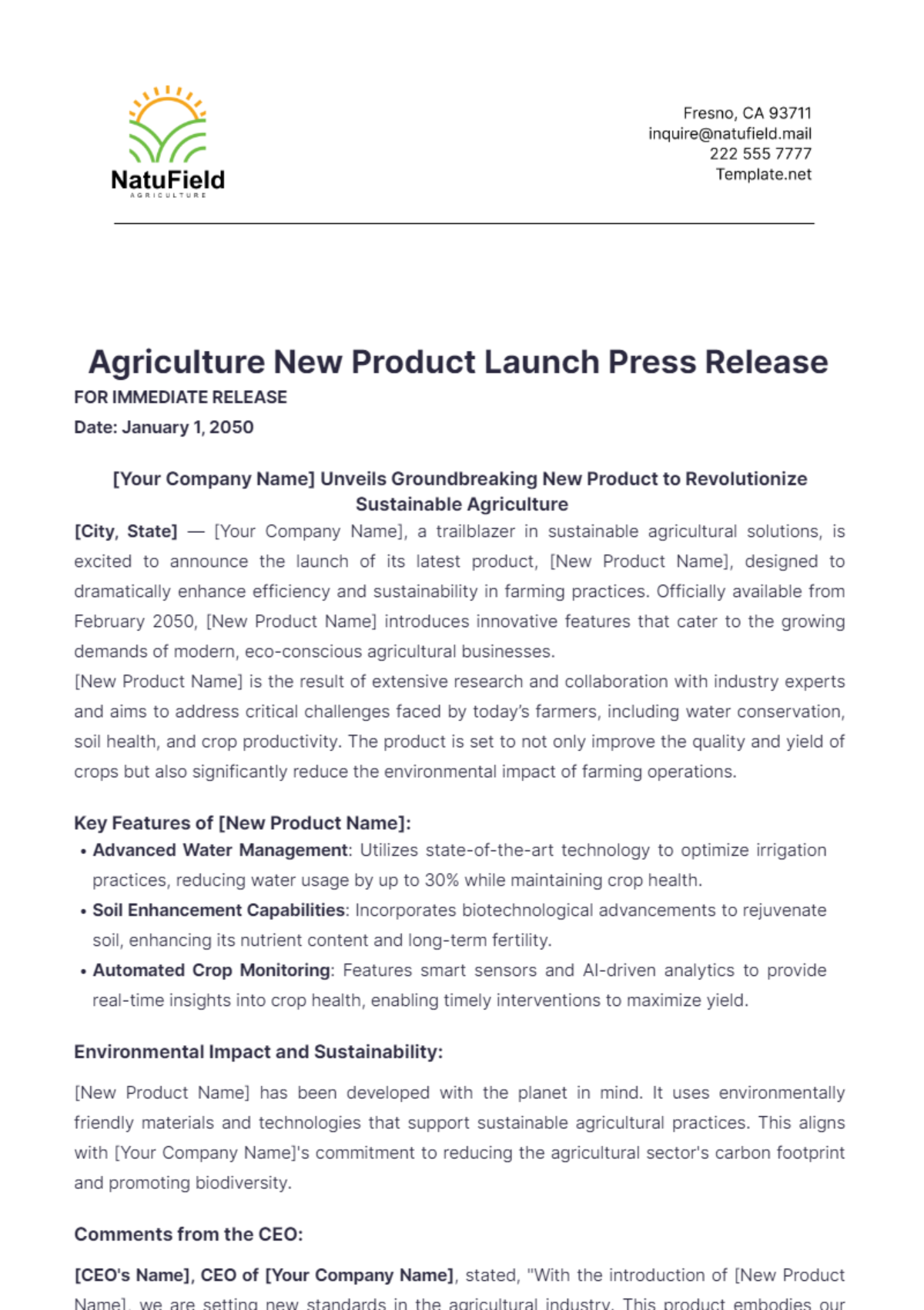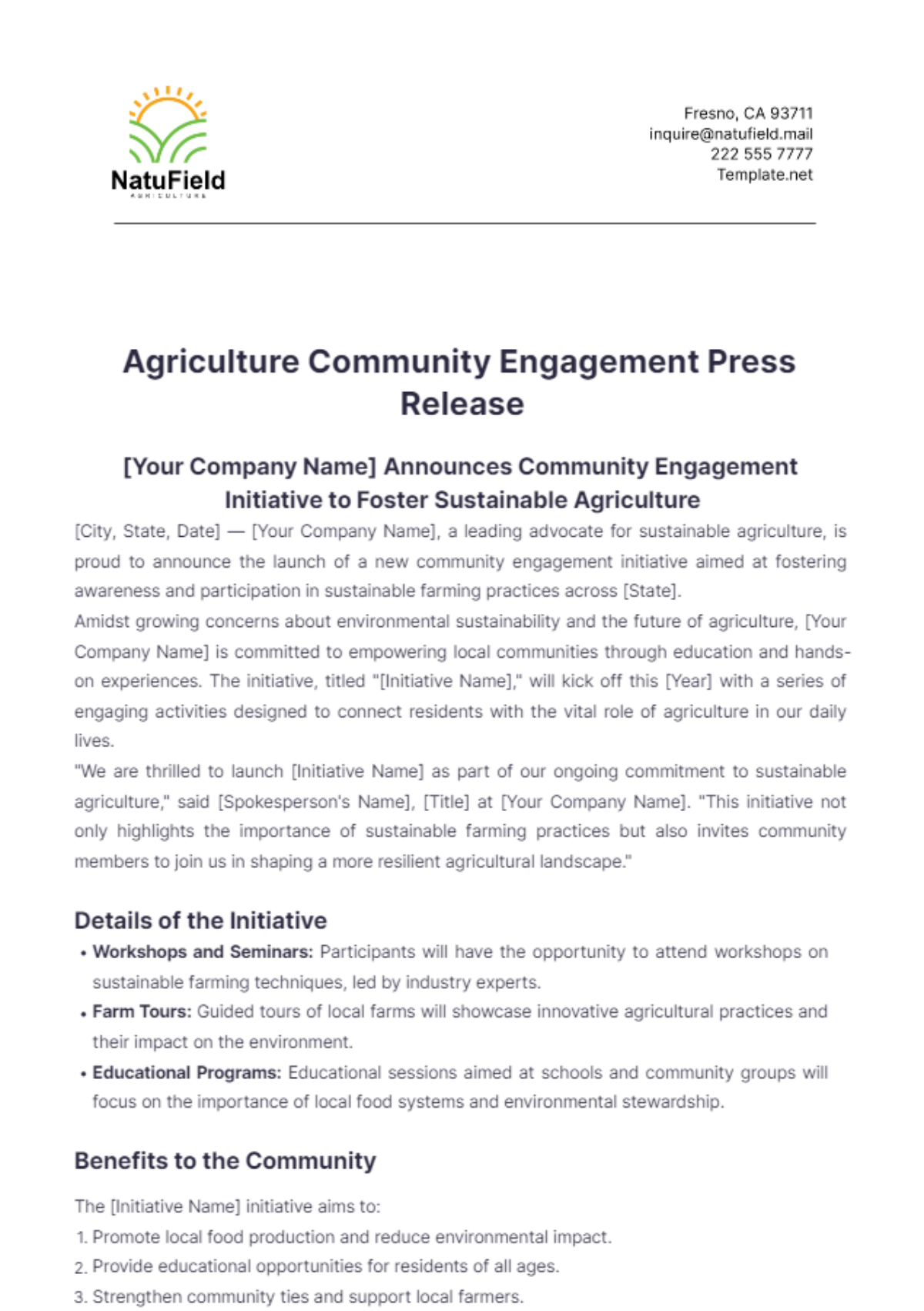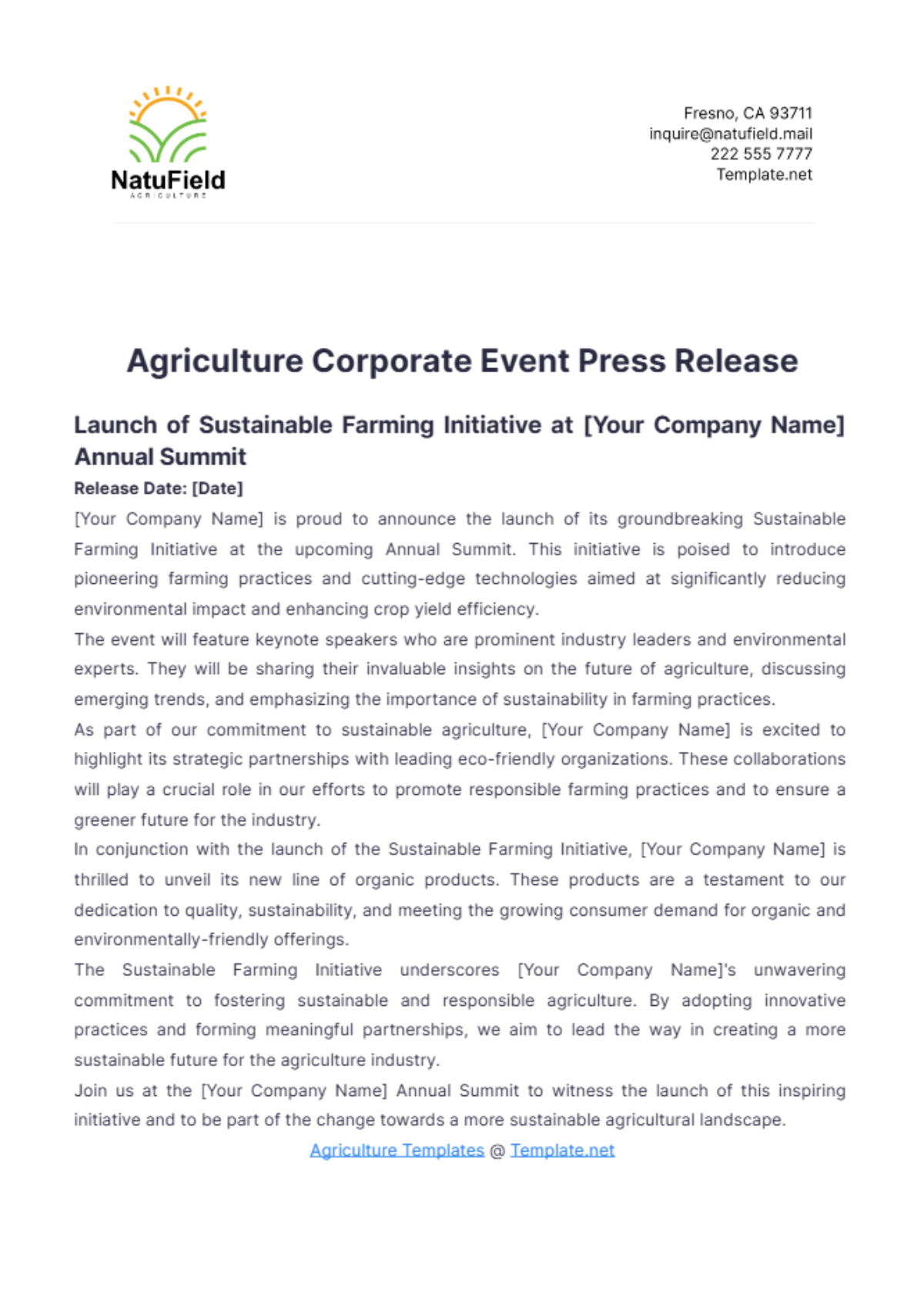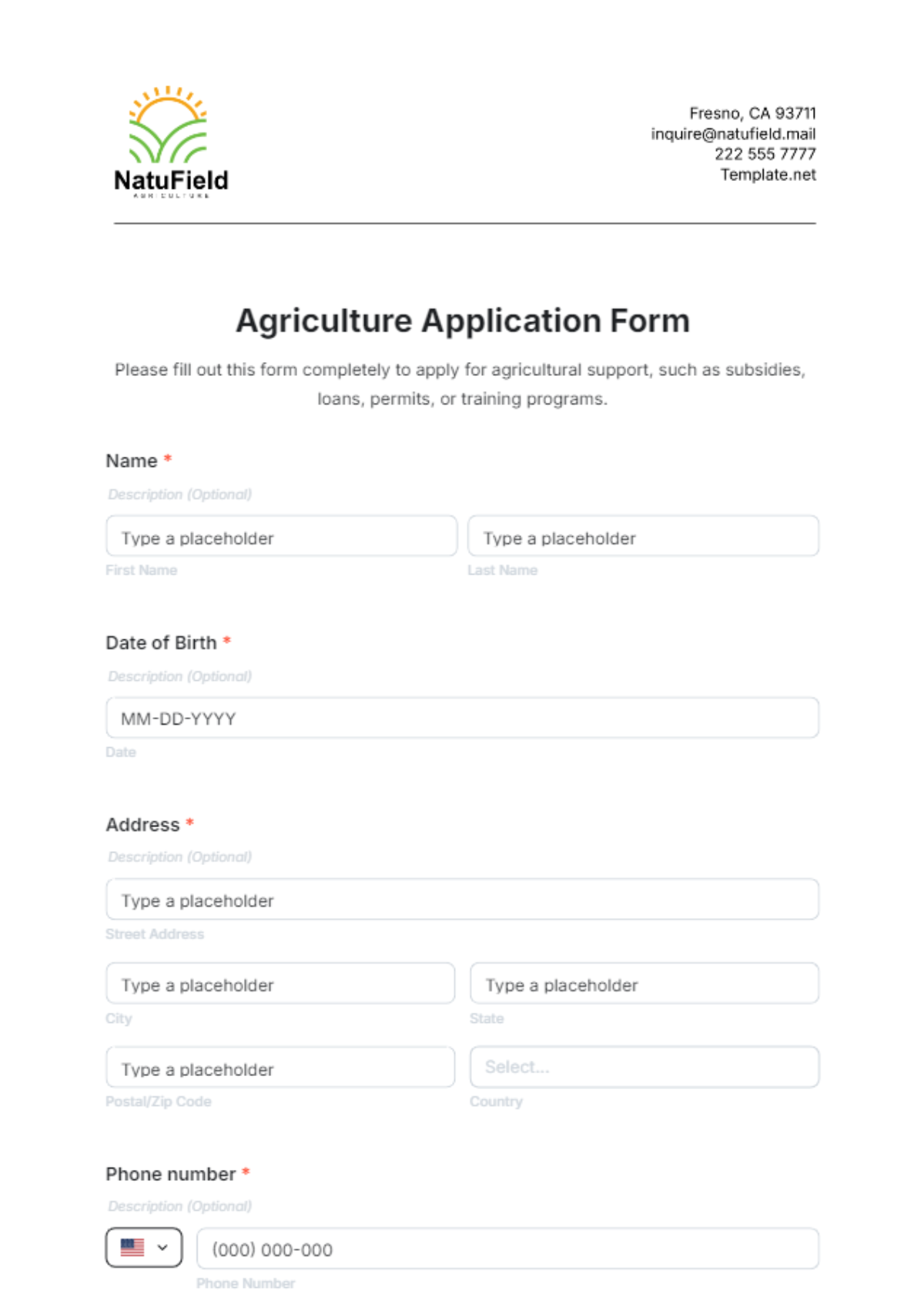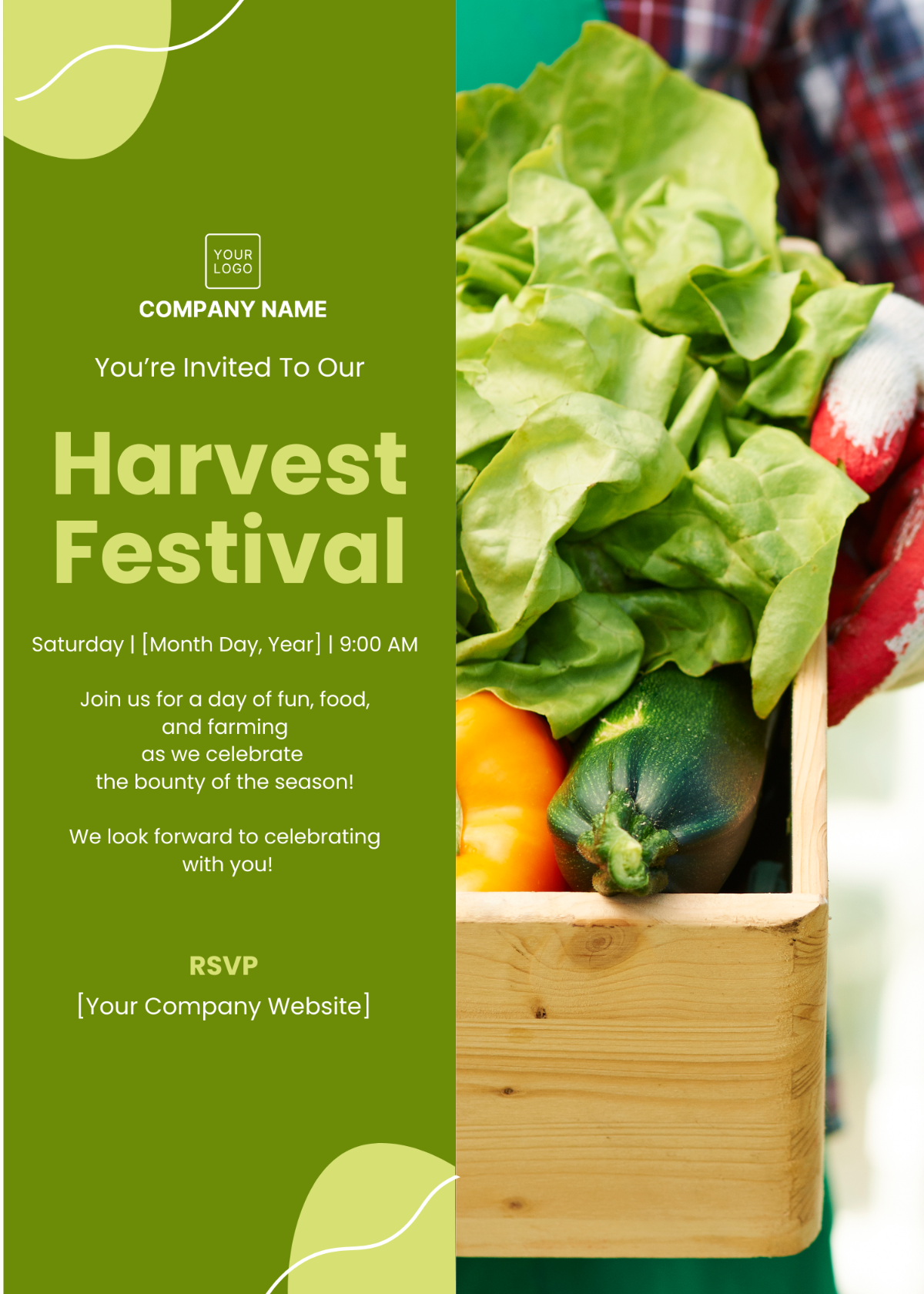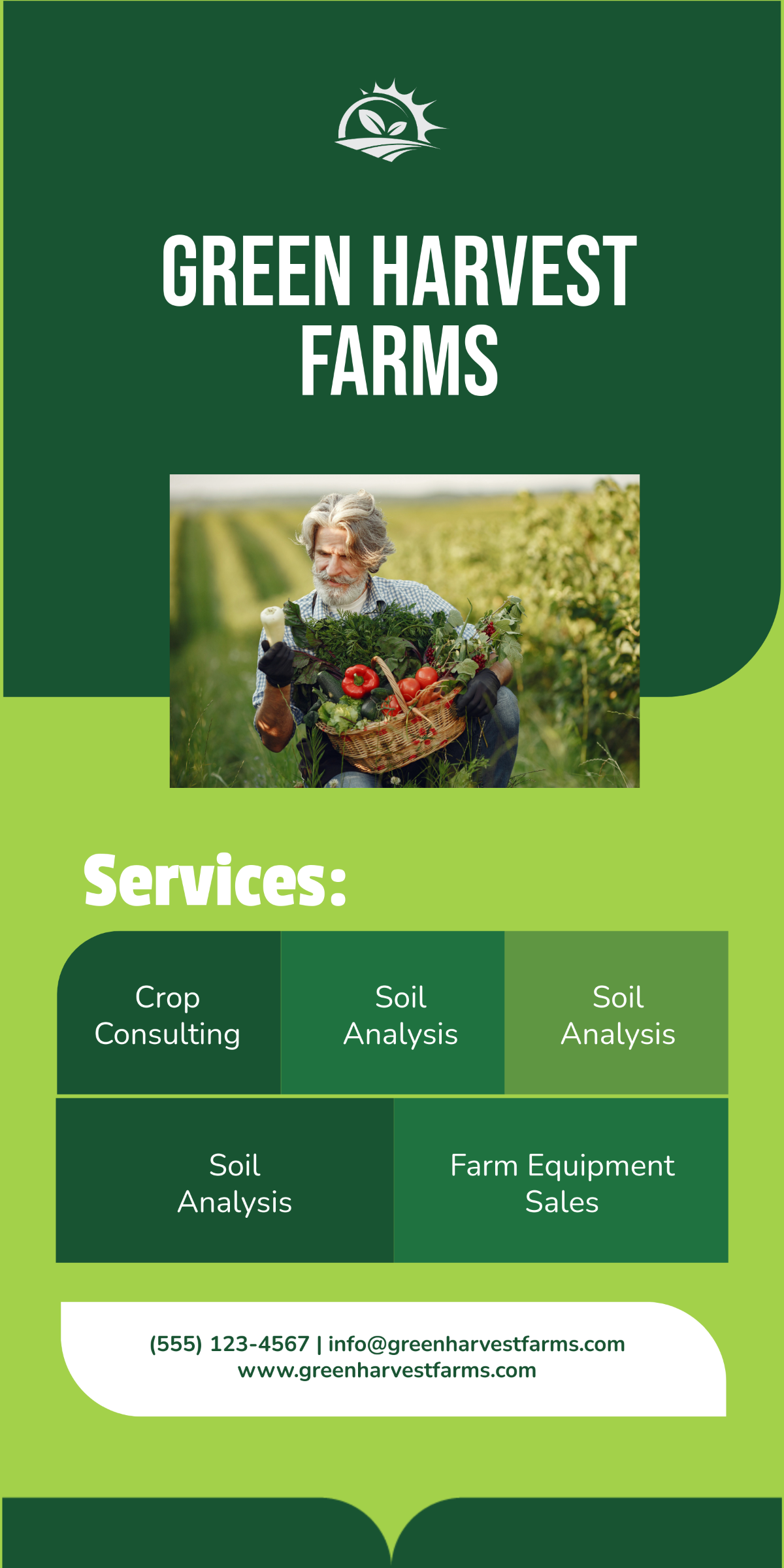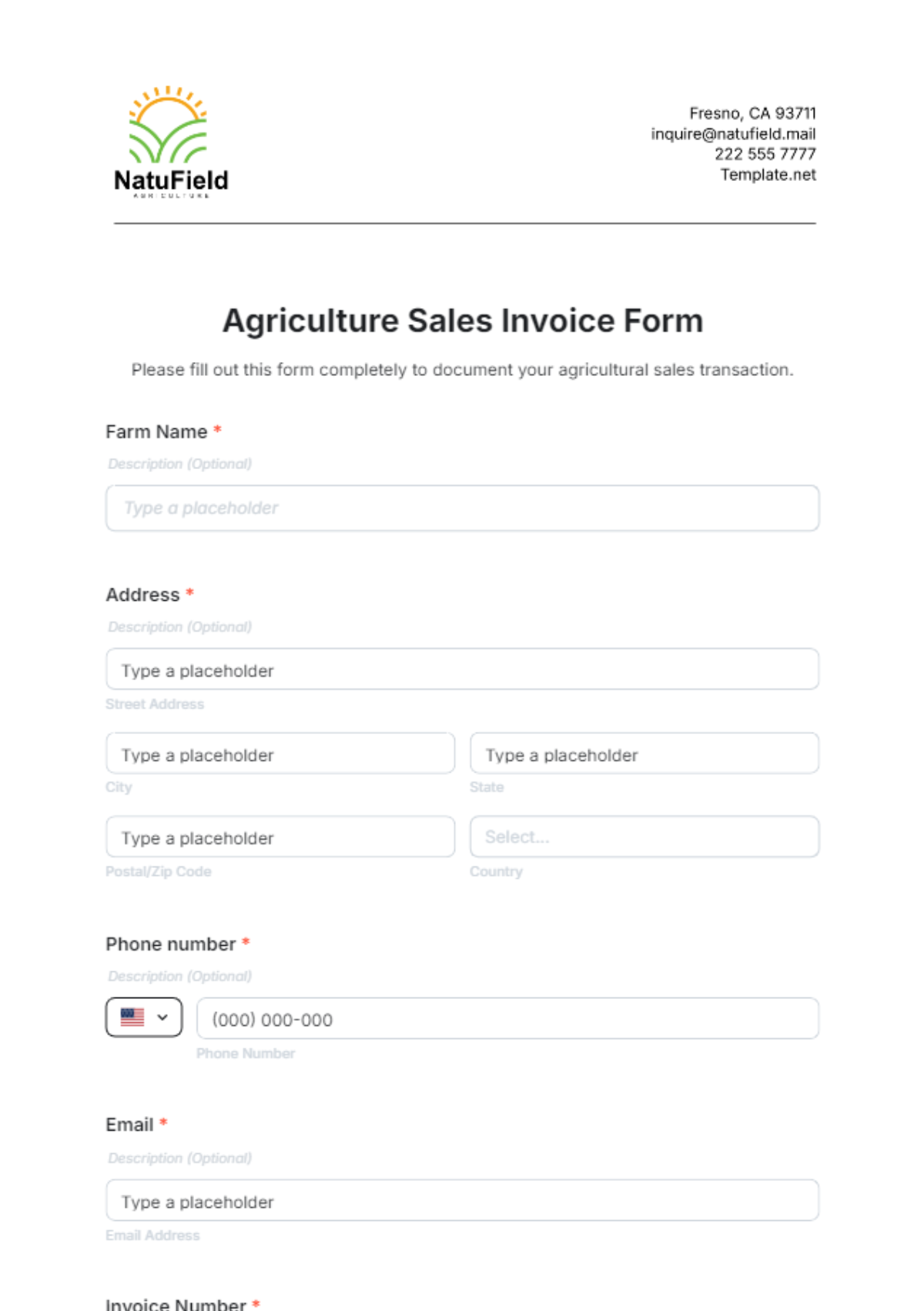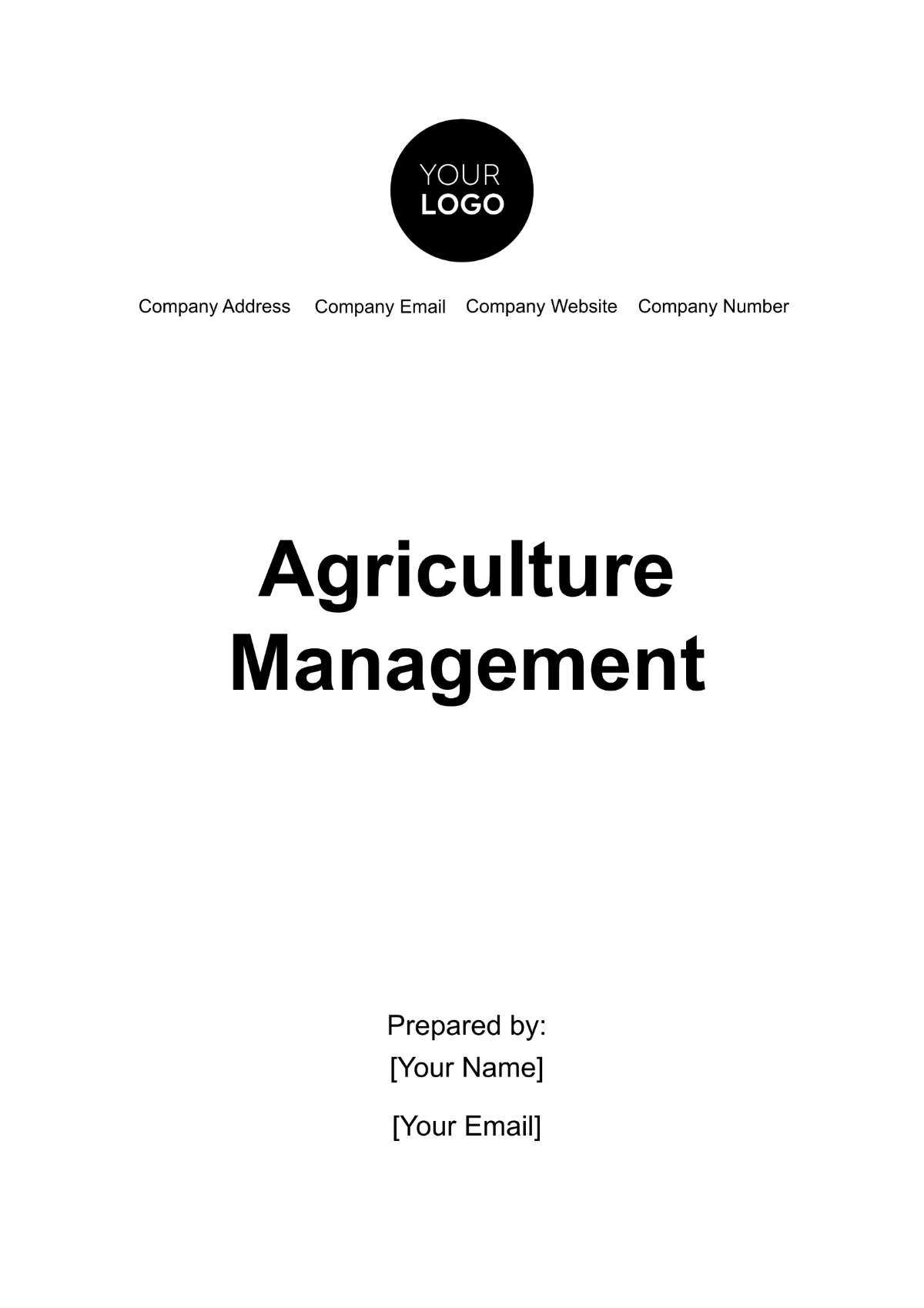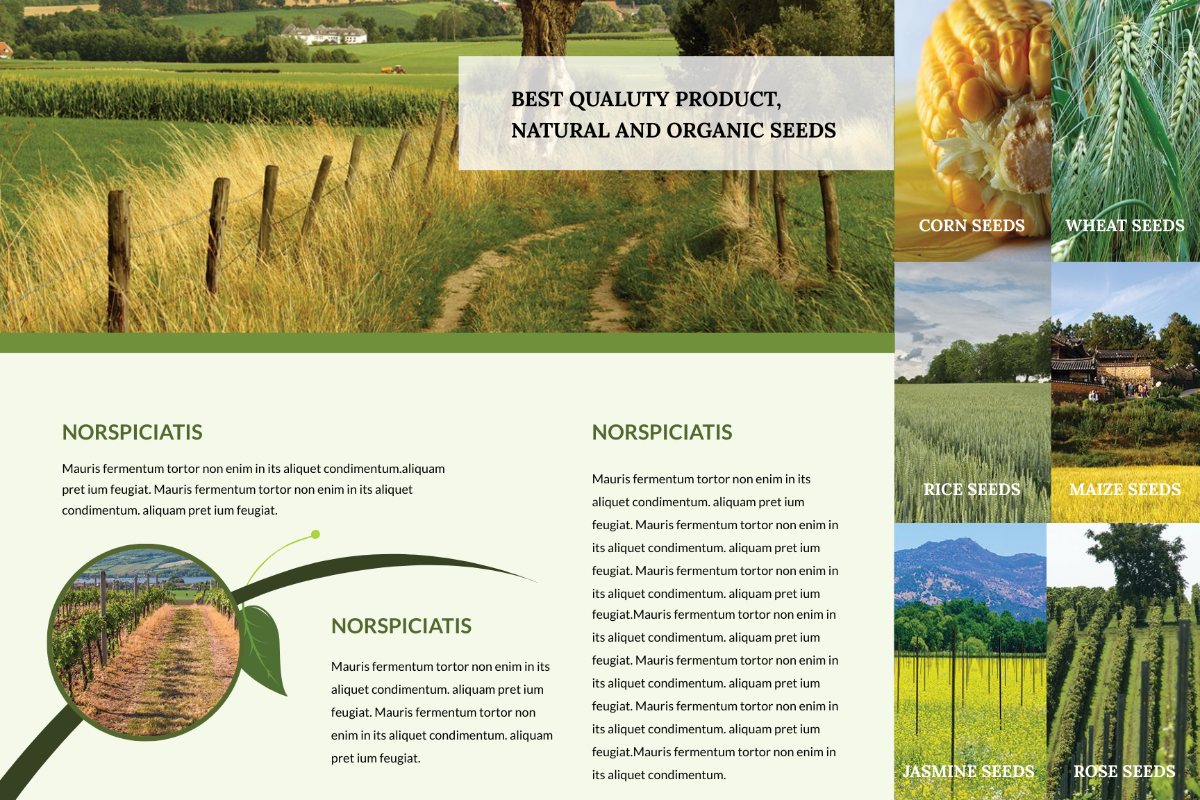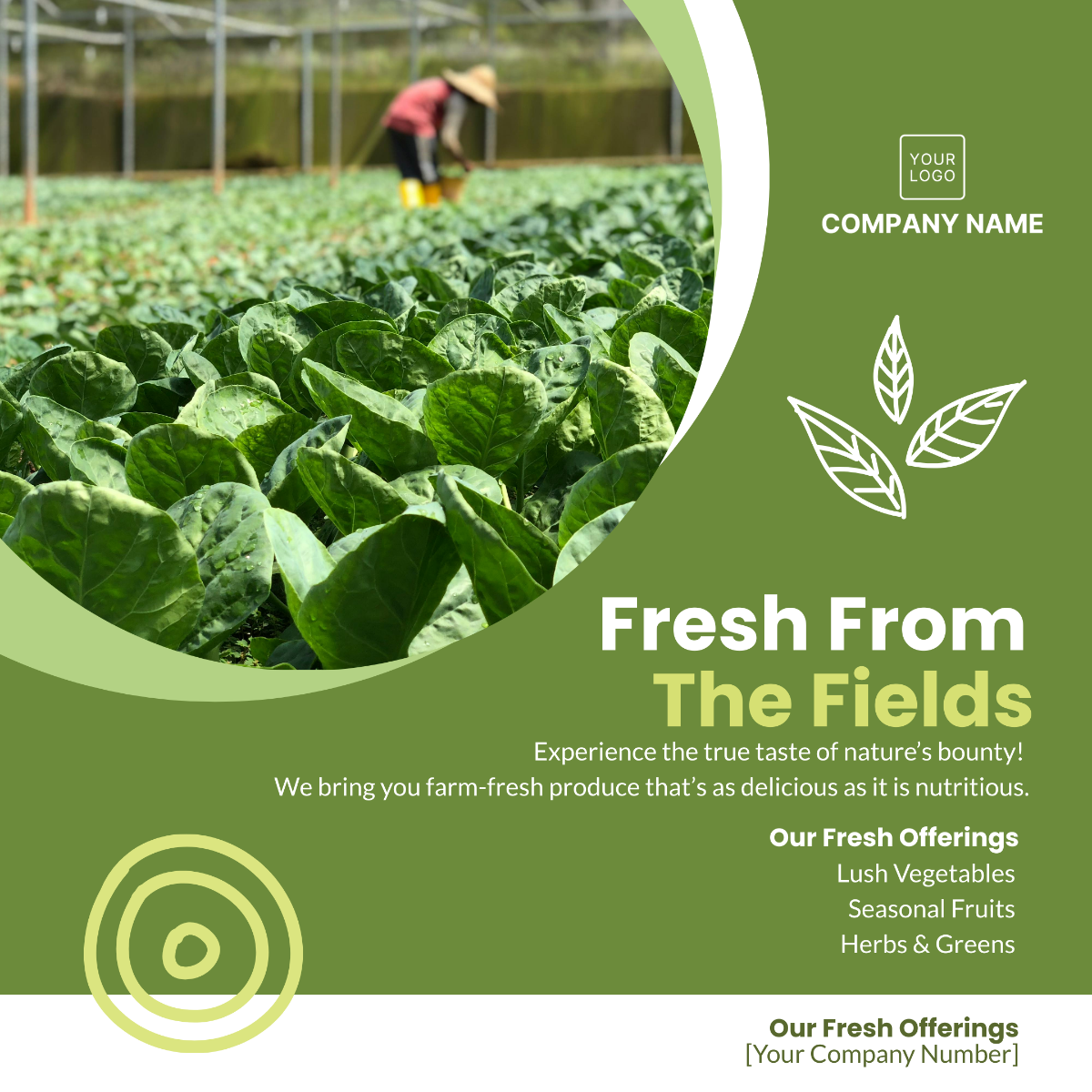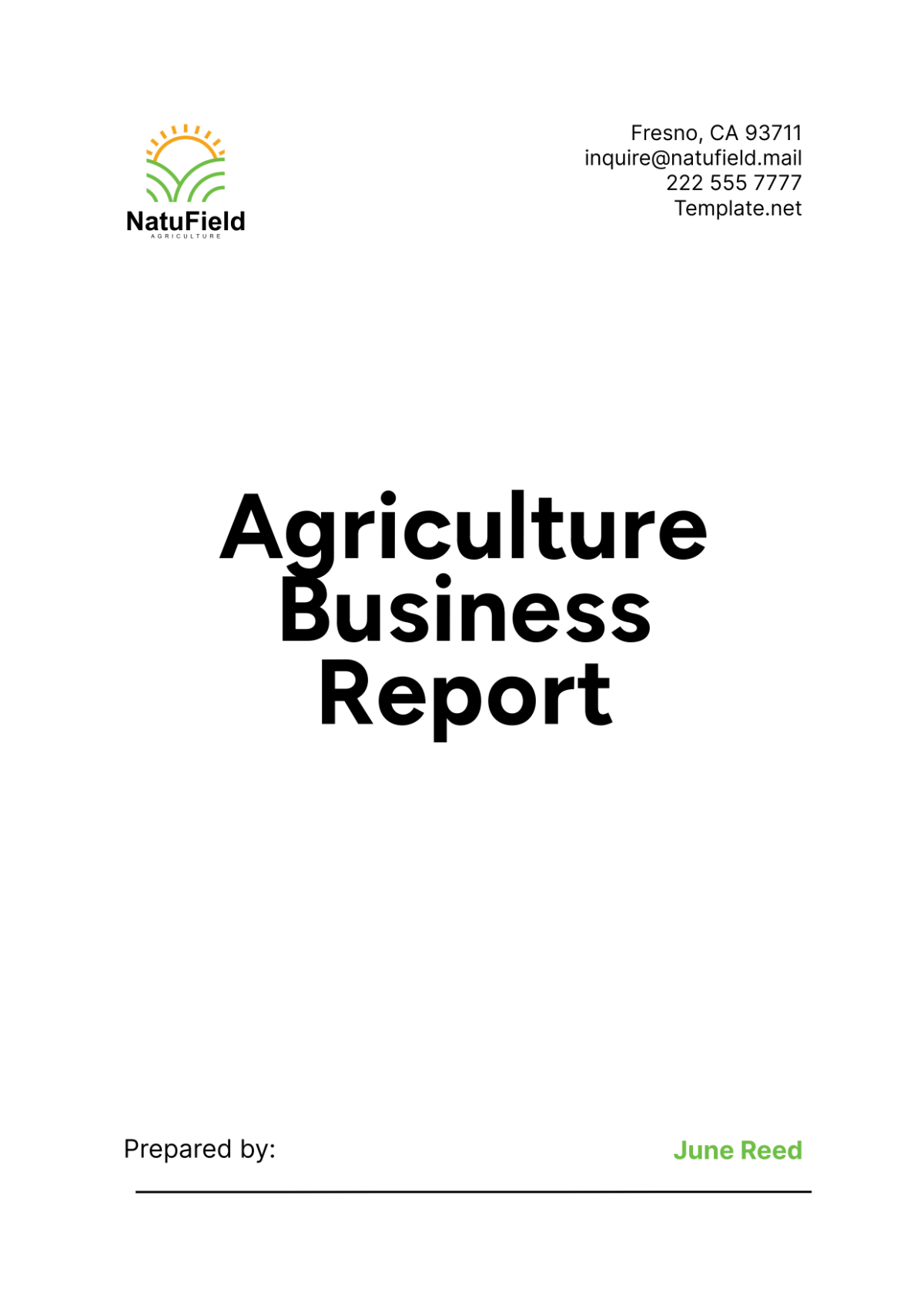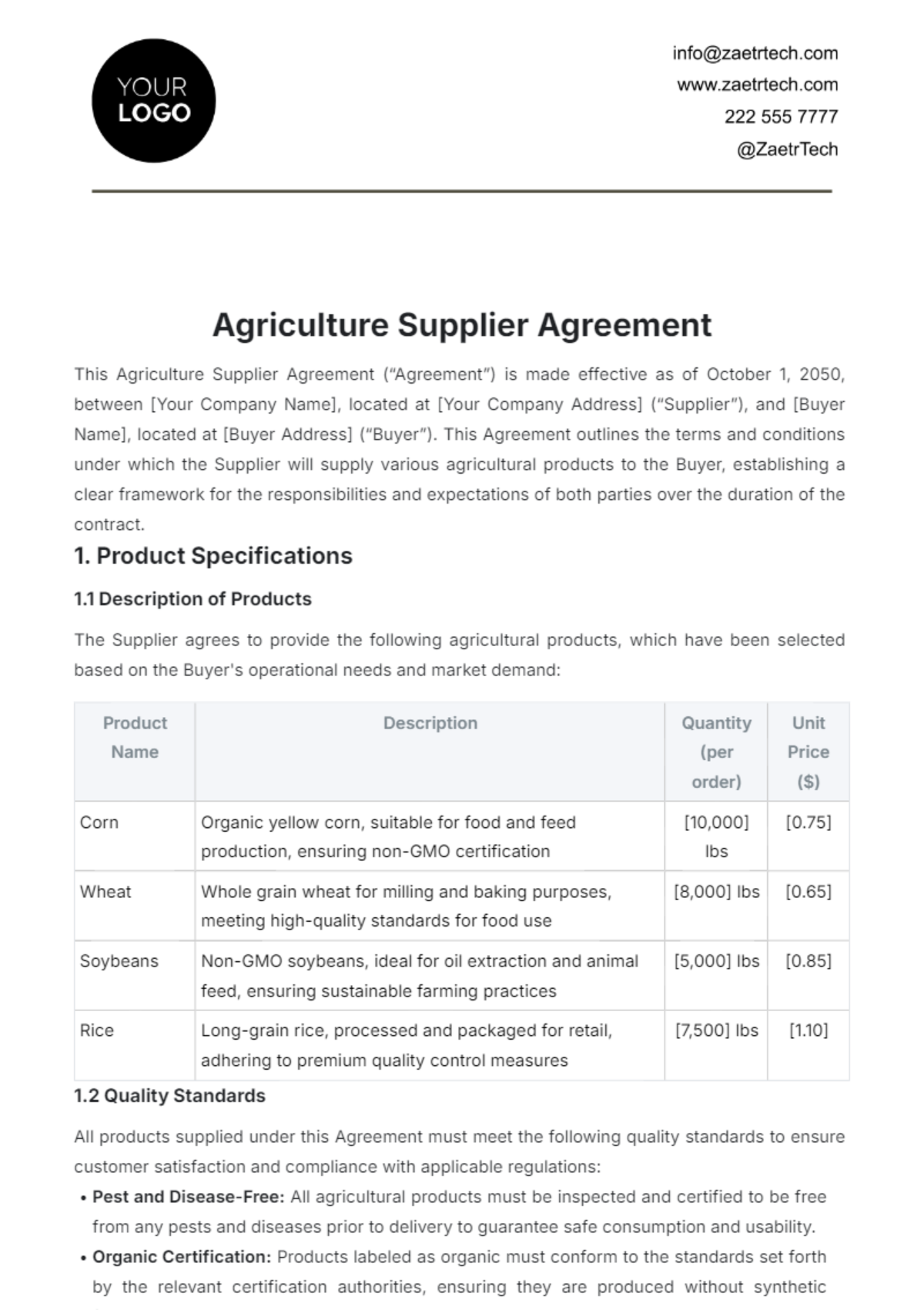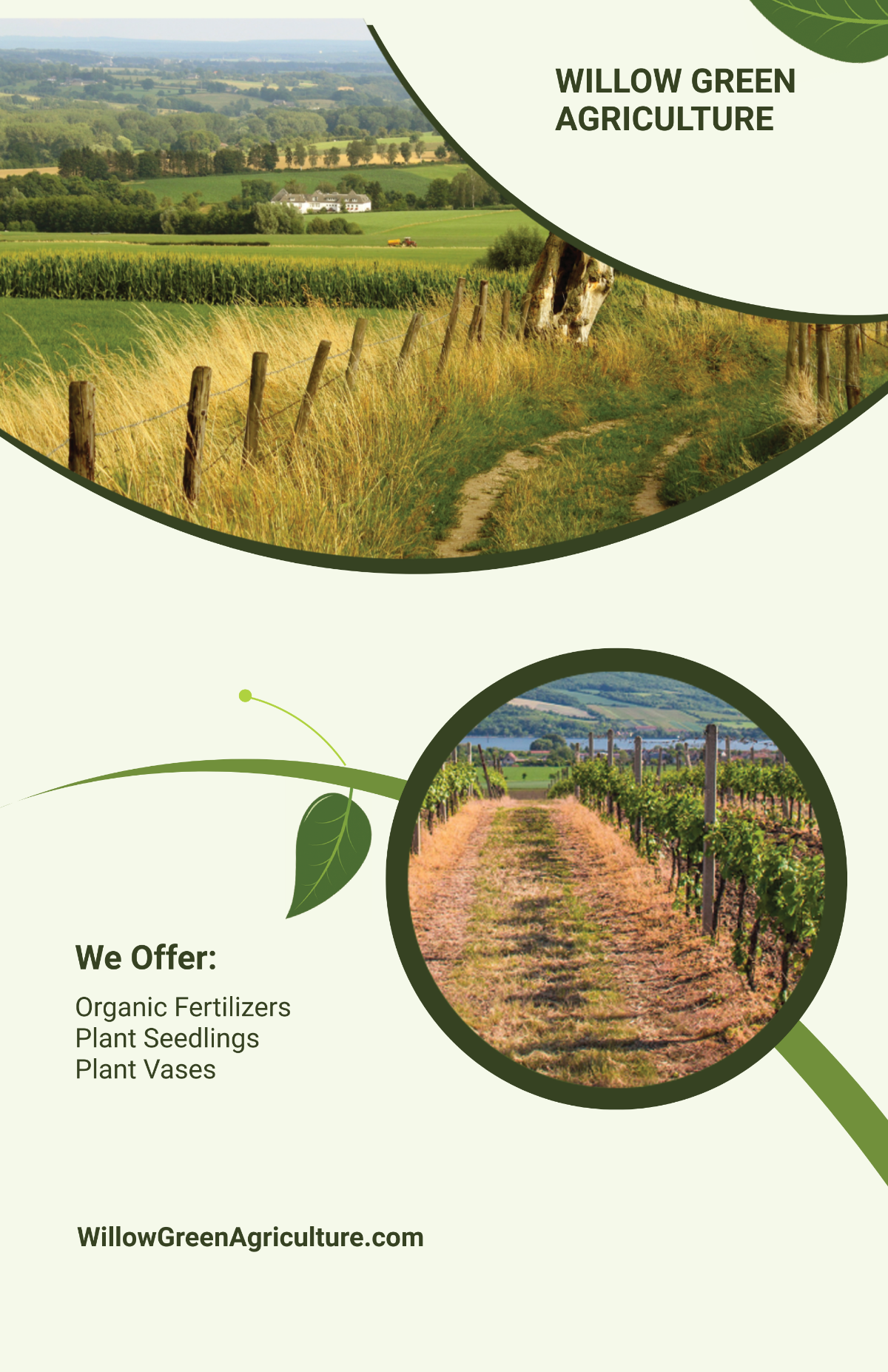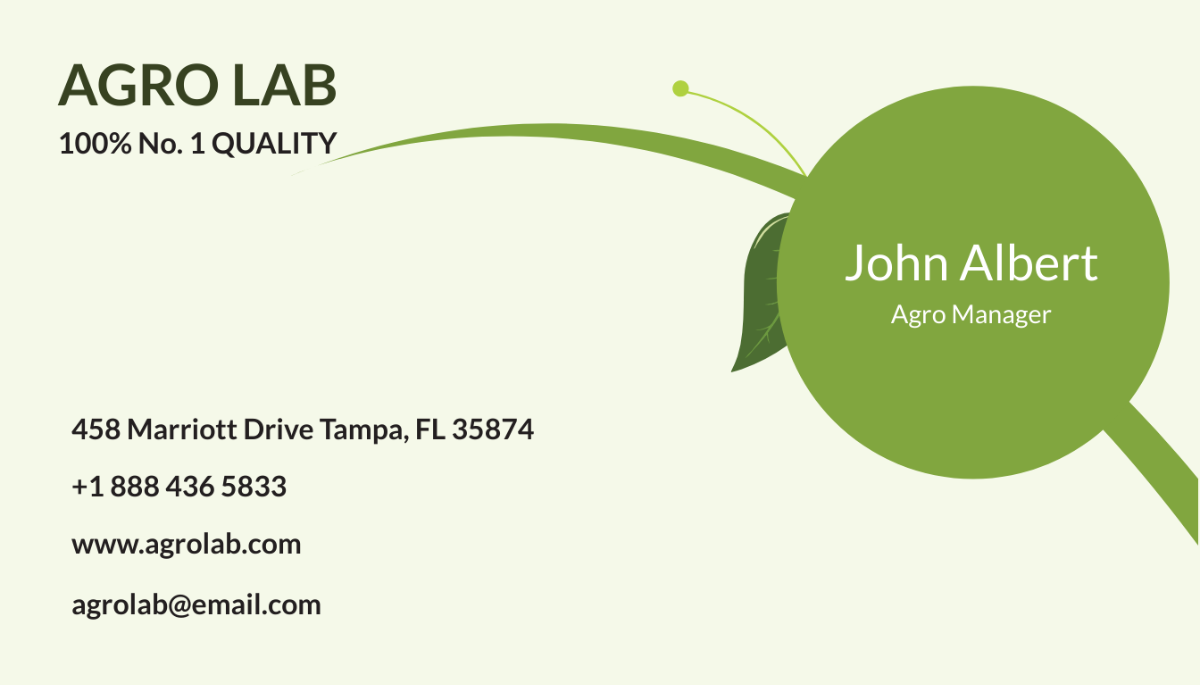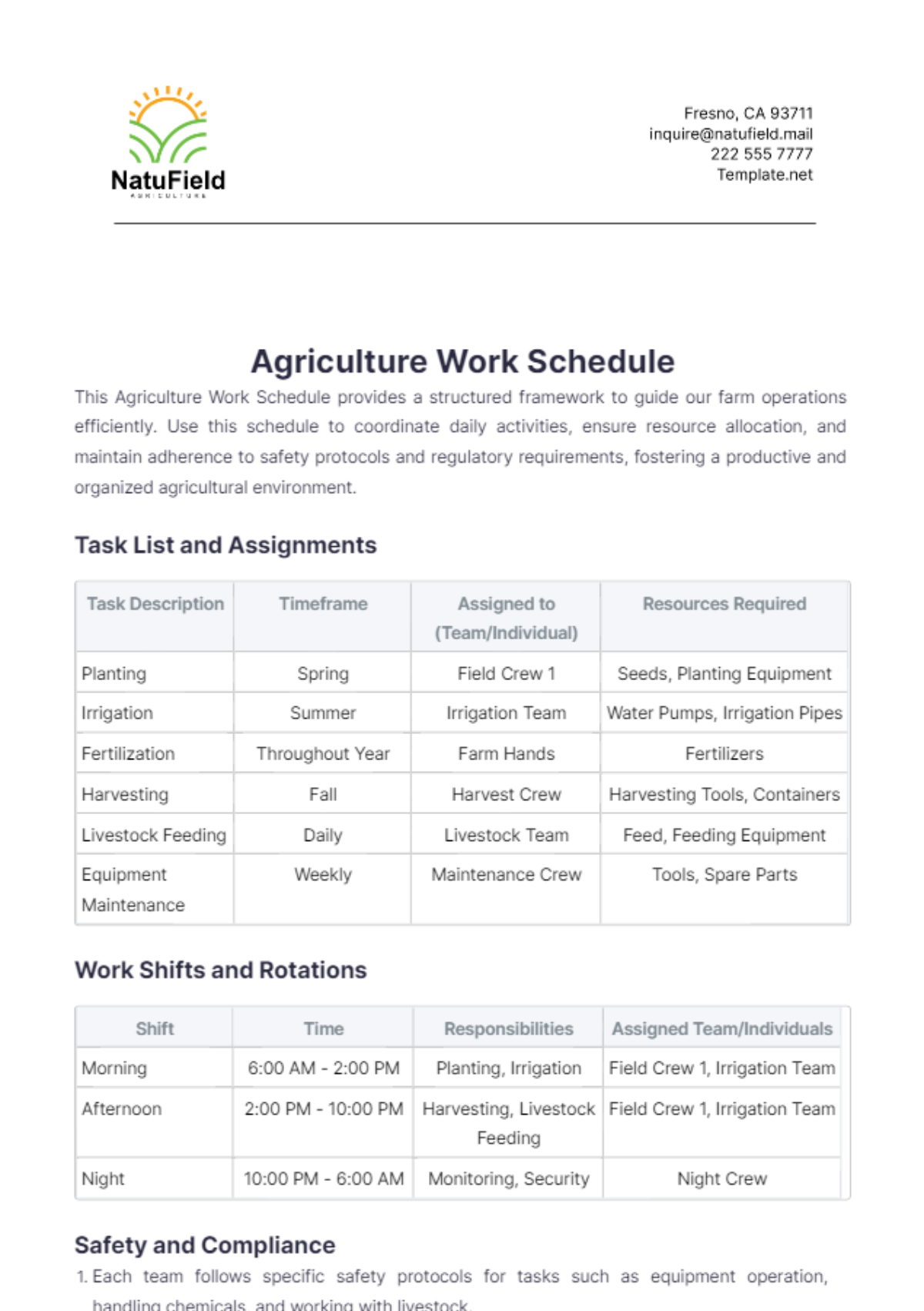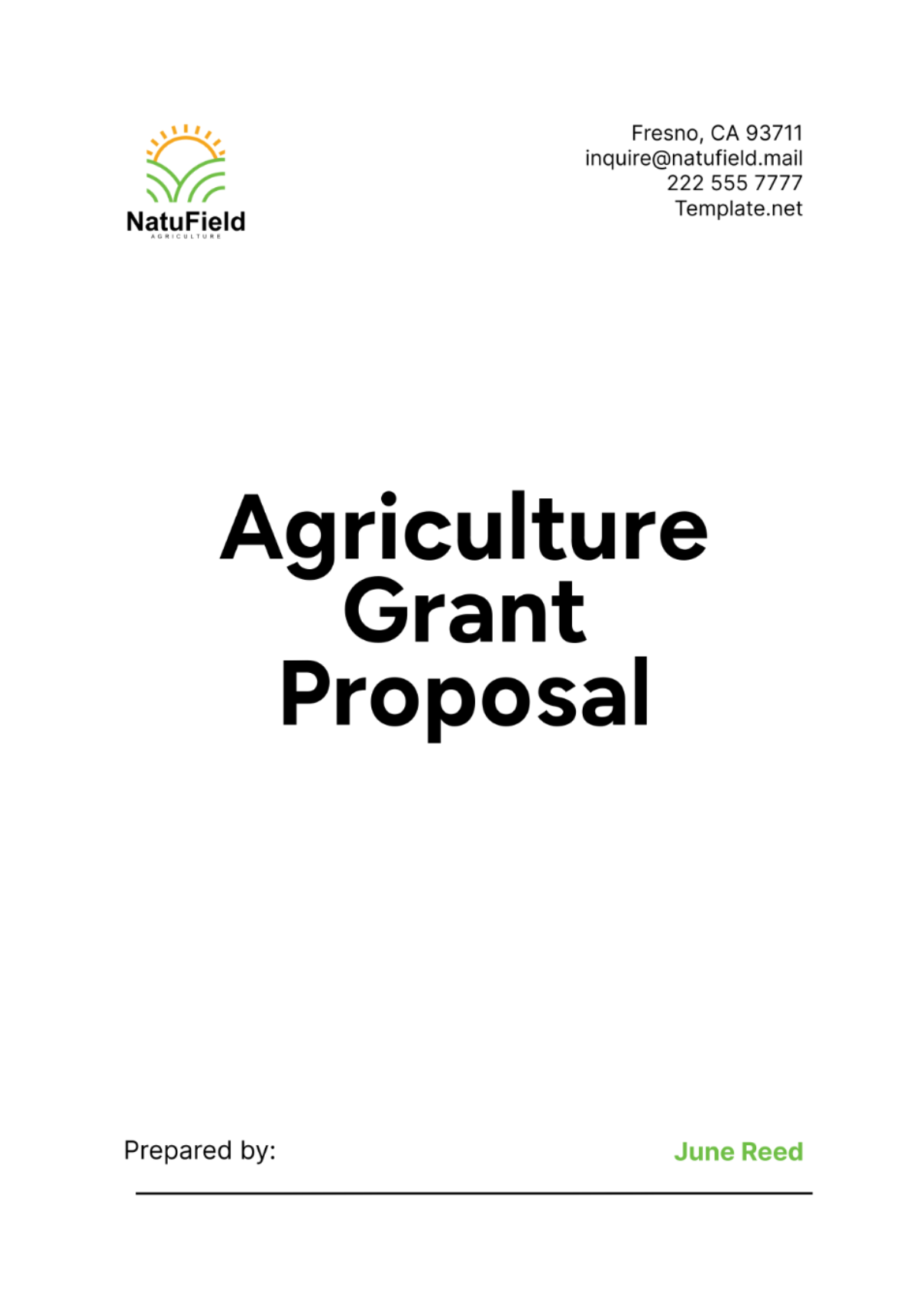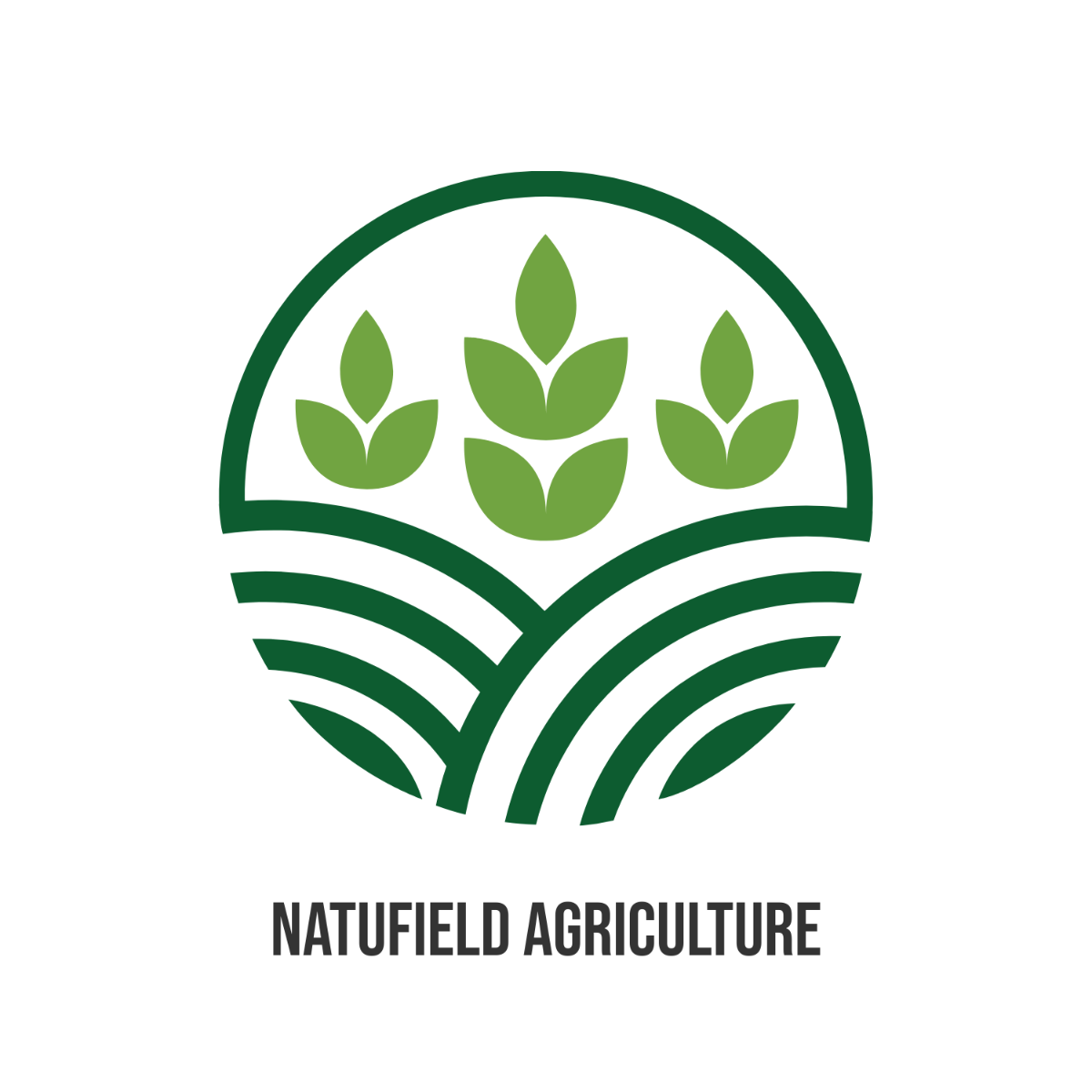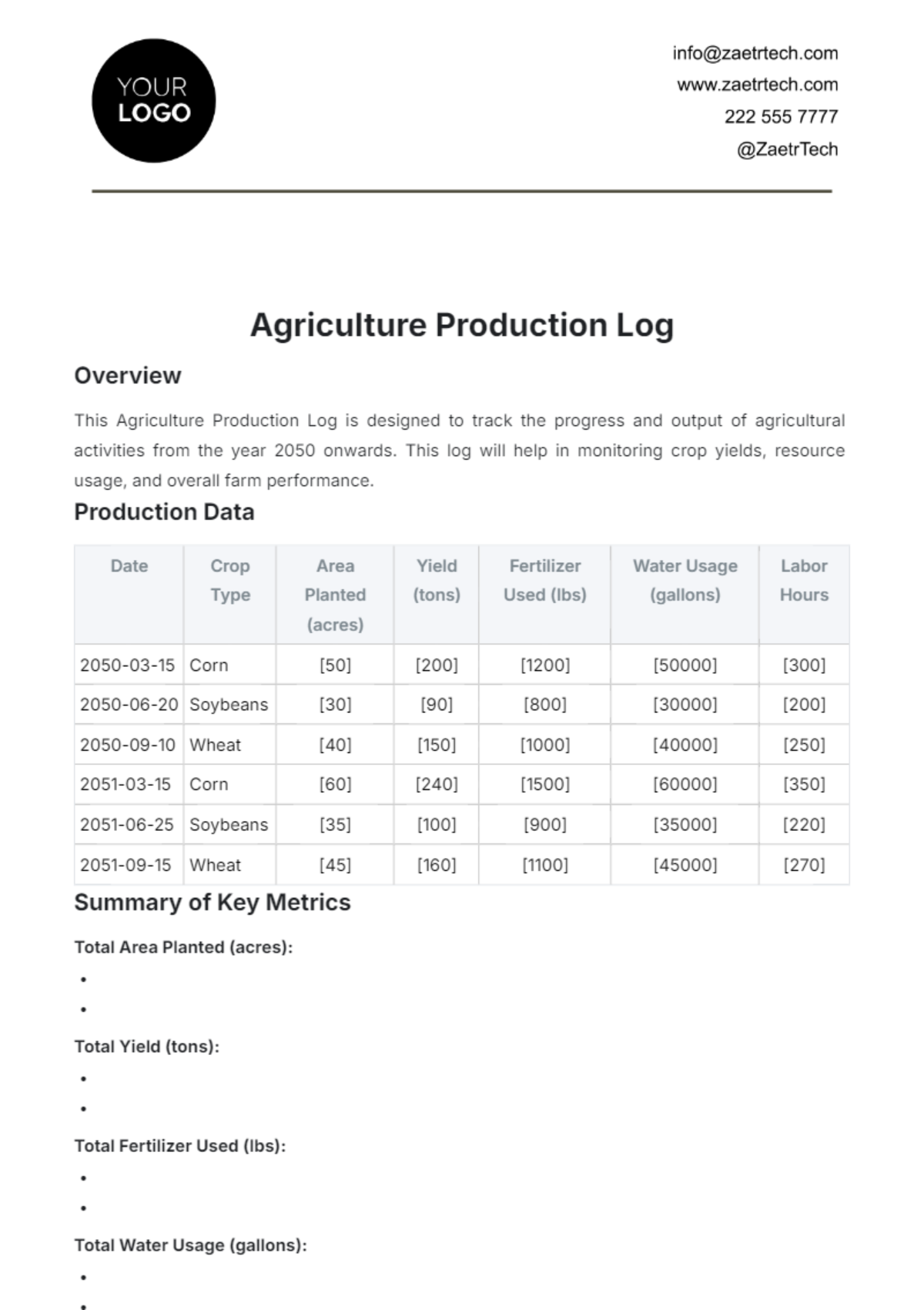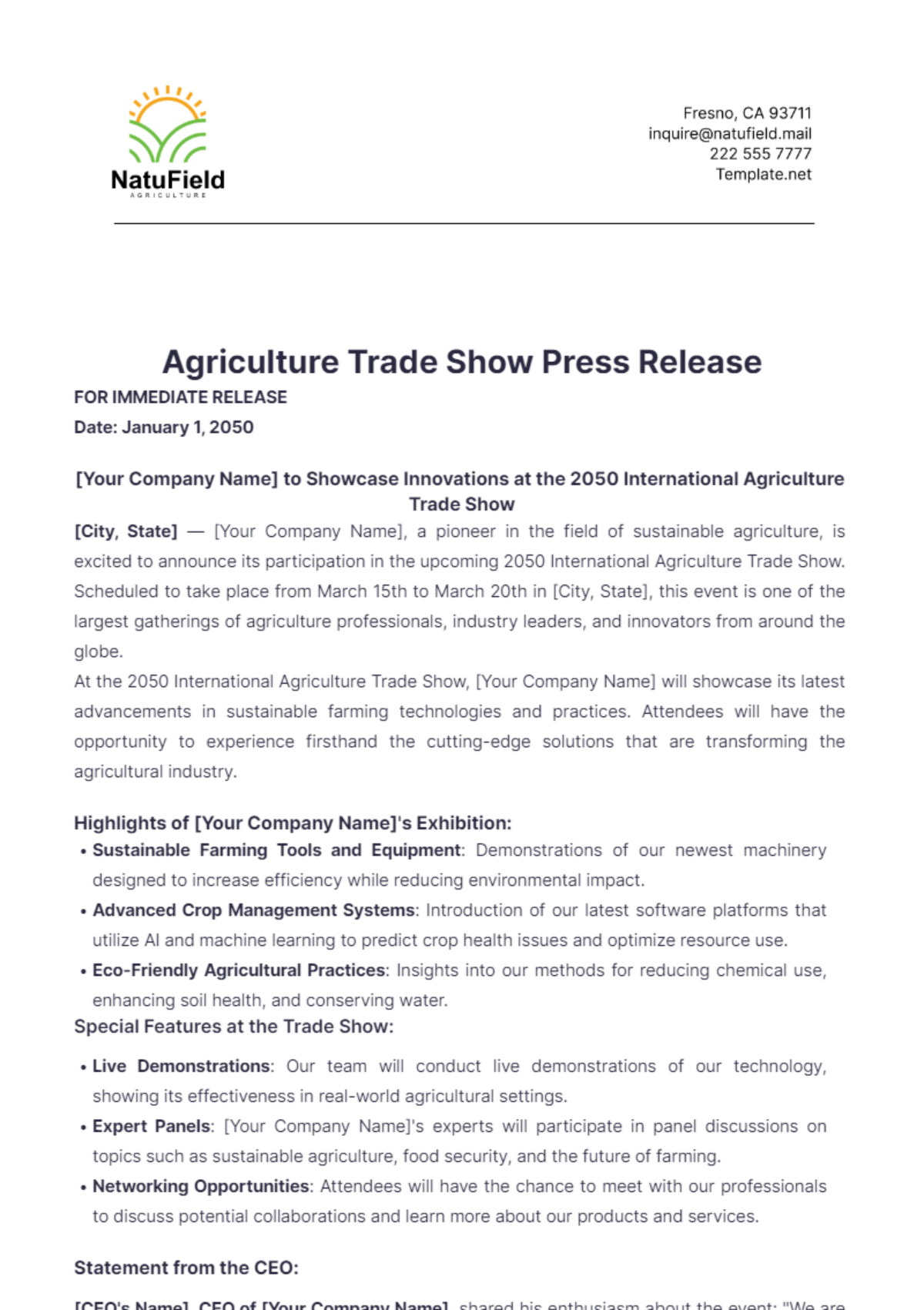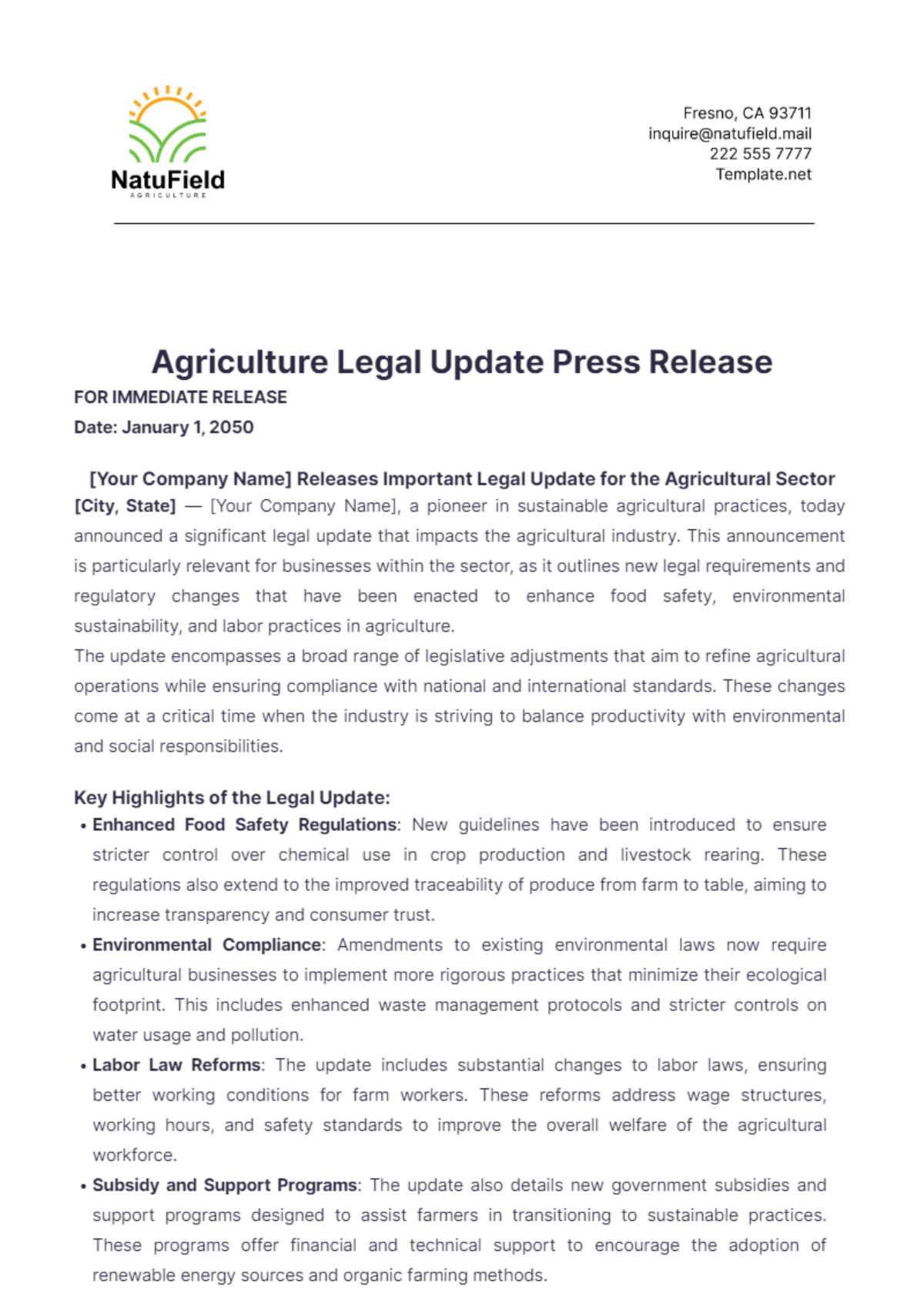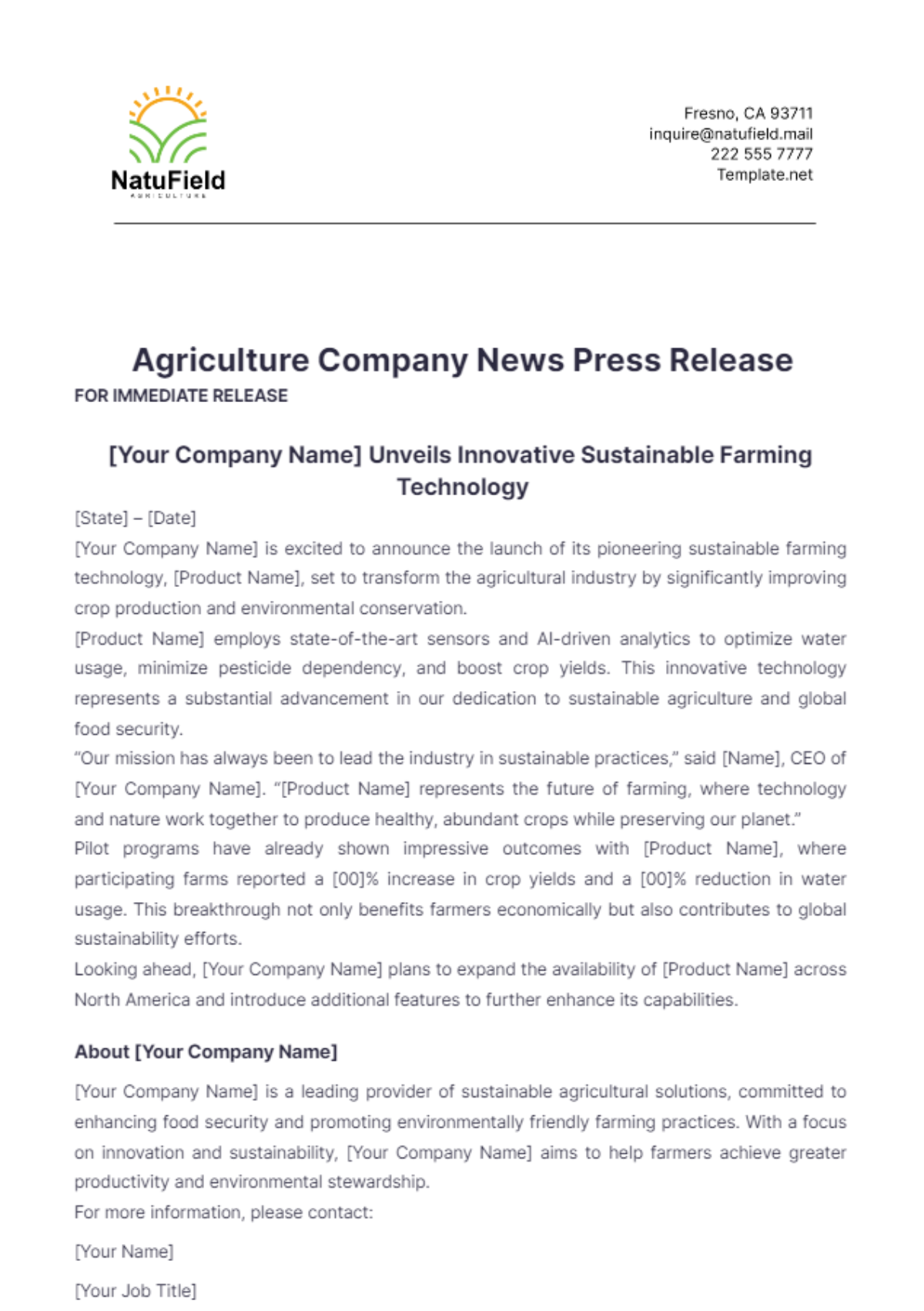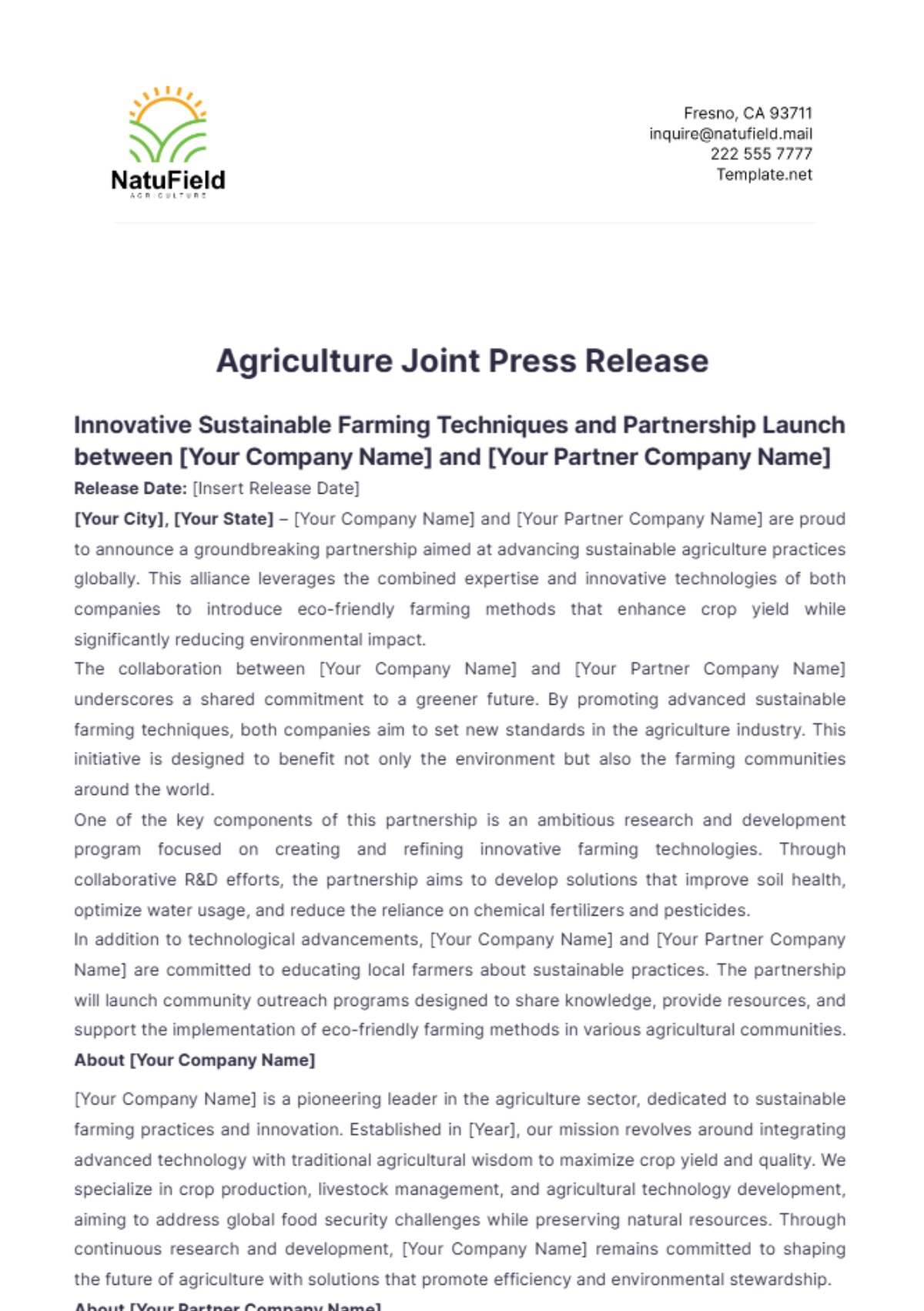Agriculture Project Feasibility Study
I. Executive Summary
A. Project Overview
The Sustainable Farming Initiative by [Your Company Name] aims to revolutionize traditional farming practices by integrating sustainable and technologically advanced methods. Located on a 500-acre plot in the Midwest, this initiative seeks to address key challenges in agriculture such as soil degradation, water scarcity, and the need for eco-friendly farming practices. By leveraging cutting-edge technologies and organic farming principles, the project intends to increase agricultural productivity while minimizing environmental impact.
B. Objectives
Enhanced Crop Yield: The primary objective is to increase crop yield by 30% within the first five years through optimized farming techniques and the use of high-yield crop varieties.
Water Conservation: Implementing advanced irrigation systems and water management strategies to reduce water usage by 25%, contributing to sustainable water resource management.
Organic Farming Practices: Transitioning to organic farming methods to improve soil health and fertility, promoting biodiversity and reducing reliance on chemical inputs.
Scalability and Sustainability: Developing a scalable model that can be replicated in other regions, promoting sustainable agriculture practices on a broader scale.
C. Key Findings
Market Demand: Consumer preference for organic produce is steadily increasing, driven by health consciousness and environmental concerns. The organic food market is projected to grow at a compound annual growth rate (CAGR) of 10%, reaching significant market size by 2055.
Technological Advancements: Advances in precision farming, including drone technology, sensors, and data analytics, present opportunities to optimize farming operations, reduce costs, and improve efficiency by up to 15%.
Financial Considerations: An initial investment of $5 million is required to cover land acquisition, infrastructure development, technology integration, and operational expenses. The project anticipates achieving break-even within five years, with a positive net profit trajectory thereafter.
Environmental Impact: The initiative is expected to reduce the carbon footprint by 20% through sustainable practices such as organic farming and efficient resource management.
D. Recommendations
Investment Strategy: Secure funding through a combination of government grants, private investments, and agricultural loans to finance initial setup costs and operational expenses.
Research and Development: Collaborate with research institutions and agricultural experts to continuously innovate and adapt to evolving farming practices and technologies.
Marketing and Distribution: Develop a robust marketing strategy to educate consumers about the benefits of organic produce and establish partnerships with retail chains and farmers' markets to expand market reach.
Community Engagement: Engage with local communities and stakeholders to gain support, address concerns, and ensure compliance with regulatory standards and environmental regulations.
II. Project Description
A. Project Background
The Sustainable Farming Initiative is situated on a prime 500-acre parcel of land in the fertile Midwest region of the United States. Historically, the area has been renowned for its agricultural productivity, making it an ideal location for implementing innovative farming practices. The project seeks to transform conventional farming methods into sustainable practices that enhance productivity, conserve natural resources, and promote environmental stewardship.
B. Project Scope
Land Preparation and Soil Analysis: The initial phase involves comprehensive soil testing to assess soil health and fertility. Soil improvement measures, including organic composting, crop rotation, and soil nutrient management, will be implemented to enhance soil quality and optimize growing conditions.
Crop Selection: Emphasis will be placed on cultivating high-demand organic crops such as vegetables, grains, and fruits suited to the local climate and market preferences. Introducing disease-resistant and high-yield crop varieties will ensure consistent production and market competitiveness.
Infrastructure Development: Critical infrastructure components include the installation of advanced irrigation systems, greenhouse facilities, storage units, and processing facilities. These infrastructure investments are essential for supporting year-round production, maintaining product quality, and minimizing post-harvest losses.
Technology Integration: Leveraging precision farming technologies such as drones, sensors, and automated irrigation systems will enable real-time monitoring of crop health, soil moisture levels, and environmental conditions. Data analytics will facilitate informed decision-making, optimizing resource allocation and operational efficiency.
C. Project Timeline
The project timeline spans several phases over a multi-year period to ensure systematic implementation and operational readiness:
Phase | Duration | Start Date | End Date |
|---|---|---|---|
Planning and Research | 6 months | March 2050 | August 2050 |
Land Preparation | 4 months | September 2050 | December 2050 |
Infrastructure Development | 8 months | January 2051 | August 2051 |
Crop Cultivation | Ongoing | September 2051 | N/A |
Marketing and Sales | Ongoing | January 2052 | N/A |
D. Project Cost Estimate
Item | Cost (USD) |
|---|---|
Land Acquisition | $1,000,000 |
Soil Improvement | $200,000 |
Infrastructure Development | $1,500,000 |
Technology Integration | $1,000,000 |
Operational Costs | $1,300,000 |
Total | $5,000,000 |
III. Market Analysis
A. Industry Overview
The global agricultural sector is undergoing significant transformation, driven by changing consumer preferences, technological advancements, and environmental sustainability concerns. In particular, the organic food market has emerged as a lucrative segment, characterized by growing demand for healthier and environmentally friendly food products. The market for organic food products is expected to reach $500 billion by 2055, reflecting a robust growth trajectory fueled by increasing health consciousness among consumers worldwide.
B. Target Market
Local Consumers: Targeting urban consumers with high disposable incomes who prioritize health and sustainability. Establishing partnerships with local farmers' markets, grocery chains, and organic food stores to expand market presence and enhance brand visibility.
Retail Chains: Collaborating with major retail chains to secure distribution agreements and introduce private label organic products. Developing tailored marketing campaigns to educate consumers about the benefits of organic produce and differentiate products in a competitive market landscape.
Export Market: Exploring export opportunities in neighboring countries with a growing appetite for organic food products. Adhering to international organic certification standards to access global markets and ensure product integrity and consumer trust.
C. Market Trends
Health and Wellness: Increasing consumer awareness of the health benefits associated with organic food consumption, including reduced exposure to pesticides and chemicals. Rising incidence of lifestyle diseases, such as obesity and diabetes, driving demand for nutritious and organic food alternatives.
Sustainability: Growing emphasis on sustainable agriculture practices that minimize environmental impact, conserve natural resources, and promote biodiversity. Government initiatives and subsidies supporting farmers' transition to organic farming methods, incentivizing adoption of eco-friendly practices.
D. Competitive Analysis
Competitor | Strengths | Weaknesses |
|---|---|---|
Green Farms | Established brand and extensive distribution network | Higher pricing compared to conventional produce |
Organic Valley | Strong brand reputation and diverse product portfolio | Limited production capacity and market reach |
Fresh Fields | Innovative farming techniques and commitment to sustainability | Relatively higher production costs and operational complexities |
E. SWOT Analysis
Strengths | Weaknesses |
|---|---|
Advanced farming techniques | High initial investment |
Experienced management team | Dependency on weather |
Opportunities | Threats |
|---|---|
Growing organic market | Intense competition from large-scale conventional farms |
Government grants and subsidies | Market volatility and price fluctuations |
IV. Technical Feasibility
A. Technology Requirements
Precision Farming Tools: Implementing state-of-the-art technologies such as drones for aerial surveys, sensors for soil moisture and nutrient analysis, and GPS-enabled equipment for precise planting and harvesting. These technologies enable real-time data collection and analysis, facilitating informed decision-making and optimizing resource allocation.
Irrigation Systems: Installing efficient irrigation systems, including drip irrigation and automated sprinkler systems, to minimize water wastage and ensure uniform distribution across cultivated areas. Utilizing soil moisture sensors and weather forecasting tools to adjust irrigation schedules based on environmental conditions and crop water requirements.
Greenhouse Technology: Deploying climate control systems within greenhouses to regulate temperature, humidity, and light levels for optimal crop growth and year-round cultivation. Incorporating hydroponic and aquaponic systems to enhance nutrient uptake and maximize productivity in controlled environments.
B. Equipment and Machinery
Equipment | Quantity | Cost per Unit (USD) | Total Cost (USD) |
|---|---|---|---|
Tractors | 5 | $50,000 | $250,000 |
Drones | 10 | $10,000 | $100,000 |
Soil Sensors | 50 | $500 | $25,000 |
Irrigation Systems | N/A | $500,000 | $500,000 |
Greenhouse Units | 20 | $25,000 | $500,000 |
C. Process Flow
Land Preparation: Clearing and leveling the land to create an optimal planting environment. Conducting comprehensive soil testing and analysis to assess nutrient levels and pH balance. Applying organic fertilizers and soil amendments to improve soil structure and fertility, promoting healthy root development and nutrient absorption.
Crop Selection: Selecting crop varieties based on market demand, climate suitability, and soil conditions. Incorporating crop rotation and intercropping techniques to optimize yield and nutrient cycling. Implementing integrated pest management (IPM) strategies to control pests and diseases while minimizing reliance on chemical pesticides.
Irrigation and Fertilization: Installing precision irrigation systems to deliver water directly to plant roots, minimizing evaporation and runoff. Monitoring soil moisture levels and nutrient concentrations using automated sensors to adjust irrigation and fertilization schedules as needed. Utilizing organic fertilizers and compost to replenish soil nutrients and improve overall soil health.
Monitoring and Maintenance: Utilizing drones and satellite imaging technology to monitor crop health, detect pest infestations, and assess overall field conditions. Conducting regular maintenance and equipment inspections to ensure optimal performance and minimize downtime. Implementing proactive measures to prevent soil erosion and conserve water resources through sustainable farming practices.
Harvesting and Post-Harvest Handling: Utilizing mechanized harvesting equipment to efficiently collect and transport crops from field to storage facilities. Implementing cold storage and processing facilities to maintain product quality and extend shelf life. Adhering to food safety and quality standards during packaging, labeling, and distribution processes to meet consumer expectations and regulatory requirements.
V. Financial Feasibility
A. Capital Investment
The total capital investment required for the Sustainable Farming Initiative is estimated at $5 million, encompassing initial setup costs, infrastructure development, technology acquisition, and operational expenses. The investment will be allocated across various project components to ensure comprehensive implementation and long-term sustainability.
B. Revenue Projections
Year | Revenue (USD) | Expenses (USD) | Net Profit (USD) |
|---|---|---|---|
2051 | $1,000,000 | $1,200,000 | -$200,000 |
2052 | $2,000,000 | $1,500,000 | $500,000 |
2053 | $3,500,000 | $1,700,000 | $1,800,000 |
2054 | $4,500,000 | $1,900,000 | $2,600,000 |
2055 | $5,000,000 | $2,000,000 | $3,000,000 |
C. Break-Even Analysis
The project is anticipated to achieve break-even within five years of operation, reflecting a phased revenue growth trajectory and strategic cost management. The break-even point marks a pivotal milestone in financial sustainability, indicating the project's ability to generate positive cash flow and achieve profitability over the long term.
D. Funding Sources
Government Grants and Subsidies: Leveraging federal and state-level agricultural grants and subsidies aimed at promoting sustainable farming practices and environmental stewardship. Securing government funding to supplement initial capital investment and reduce financial risk associated with project implementation.
Private Investors and Venture Capital: Attracting private investors and venture capital firms interested in supporting innovative agricultural projects with potential for scalable growth and impact. Offering equity stakes or convertible debt securities to incentivize investment and align interests with long-term project success.
Agricultural Loans and Financing: Accessing agricultural loans and financing options tailored to the unique needs of the project, including equipment leasing, working capital loans, and construction financing. Collaborating with financial institutions and agricultural lenders to structure favorable loan terms and repayment schedules based on projected cash flow and revenue generation.
VI. Organizational Feasibility
A. Management Team
Project Manager: Responsible for overseeing project execution, resource allocation, and strategic planning. Possesses extensive experience in agricultural management and operations, with a proven track record of delivering successful farming projects on schedule and within budget.
Technical Lead: Leads technology integration and innovation initiatives, ensuring seamless deployment of precision farming tools and sustainable agricultural practices. Holds a degree in Agricultural Engineering and brings specialized expertise in agronomy, soil science, and environmental sustainability.
Marketing Manager: Develops and implements comprehensive marketing strategies to promote organic produce and build brand awareness. Utilizes market research and consumer insights to identify target demographics and optimize promotional campaigns across various channels, including digital media, retail partnerships, and community outreach.
Financial Analyst: Manages project finances, budgeting, and financial reporting. Provides financial forecasting and analysis to support decision-making and strategic planning. Implements cost-control measures and risk management strategies to mitigate financial risks and optimize investment returns.
B. Staffing Requirements
Position | Number of Employees | Salary per Employee (USD) | Total Salary (USD) |
|---|---|---|---|
Farm Workers | 50 | $30,000 | $1,500,000 |
Technical Staff | 10 | $50,000 | $500,000 |
Administrative Staff | 5 | $40,000 | $200,000 |
Marketing Team | 5 | $60,000 | $300,000 |
The staffing plan outlines key positions essential for project implementation and operational management, ensuring a skilled workforce capable of executing daily farming operations, maintaining technological infrastructure, managing administrative tasks, and driving marketing initiatives to promote organic produce and expand market reach.
VII. Environmental Impact Assessment
A. Positive Impacts
Soil Health Improvement: Adopting organic farming practices, such as crop rotation, cover cropping, and composting, to enhance soil fertility and structure. Promoting beneficial microbial activity and nutrient cycling within the soil ecosystem to support sustainable crop production and long-term soil health.
Water Conservation: Implementing efficient irrigation systems, including drip irrigation and soil moisture sensors, to optimize water use efficiency and minimize water wastage. Reducing reliance on conventional irrigation methods and promoting responsible water management practices to conserve freshwater resources and mitigate environmental impact.
Reduction in Chemical Usage: Transitioning from chemical-based pesticides and fertilizers to organic alternatives, such as biopesticides and natural soil amendments. Minimizing chemical residues in soil, water, and food products to improve ecological integrity, protect biodiversity, and promote ecosystem resilience in agricultural landscapes.
B. Potential Negative Impacts
Initial Land Disturbance: Temporary disruption of soil structure and ecosystem balance during land preparation activities, including site clearing and earthwork operations. Implementing soil erosion control measures, such as contour plowing and vegetative buffer strips, to minimize environmental disturbance and promote soil conservation practices.
Energy Consumption: Increased energy demand associated with greenhouse operations, climate control systems, and mechanized farming equipment. Integrating renewable energy sources, such as solar panels and wind turbines, to offset energy consumption and reduce greenhouse gas emissions from agricultural production activities.
C. Mitigation Measures
Sustainable Land Management: Implementing agroecological practices, such as agroforestry and integrated pest management (IPM), to enhance biodiversity and ecosystem services. Integrating wildlife habitat restoration and conservation initiatives to support native species diversity and ecological resilience in agricultural landscapes.
Renewable Energy: Investing in renewable energy infrastructure, including solar photovoltaic systems and biomass energy technologies, to reduce dependency on fossil fuels and mitigate greenhouse gas emissions from agricultural operations. Promoting energy efficiency measures, such as LED lighting and energy-efficient equipment, to optimize resource use and minimize environmental footprint.
D. Regulatory Compliance
Environmental Permits: Obtaining necessary permits and regulatory approvals for land use, water rights, and environmental impact assessments. Complying with federal, state, and local regulations governing agricultural practices, water quality standards, and wildlife habitat protection measures.
Organic Certification: Achieving organic certification from accredited certifying agencies to verify compliance with organic farming standards and consumer expectations. Adhering to organic production guidelines, including prohibited substances, crop rotation requirements, and soil conservation practices, to maintain product integrity and market competitiveness.
VIII. Risk Assessment
A. Identified Risks
Weather Dependency: Unpredictable weather patterns, including droughts, floods, and extreme temperature fluctuations, affecting crop growth, yield, and harvest timing. Implementing climate-resilient farming practices and diversified crop planning strategies to mitigate weather-related risks and ensure crop productivity under varying environmental conditions.
Market Volatility: Fluctuations in market demand, consumer preferences, and commodity prices impacting revenue generation and profitability. Developing diversified marketing channels, including direct-to-consumer sales, retail partnerships, and export markets, to mitigate market volatility and enhance revenue stability throughout the agricultural production cycle.
Pest and Disease Outbreaks: Outbreaks of pests, diseases, and invasive species posing threats to crop health, yield potential, and market quality standards. Implementing integrated pest management (IPM) strategies, biological pest control methods, and disease-resistant crop varieties to minimize pest pressure and mitigate crop losses without relying on chemical pesticides.
B. Risk Mitigation Strategies
Diversified Crop Planning: Rotating crops, planting cover crops, and intercropping multiple crop varieties to optimize soil health, nutrient cycling, and pest management. Integrating climate-resilient crop species and hybrid varieties to enhance crop diversity and resilience to environmental stressors, ensuring continuous production and market supply.
Insurance Coverage: Securing comprehensive crop insurance coverage, including crop yield insurance, revenue protection insurance, and weather index-based insurance, to mitigate financial losses associated with adverse weather events, natural disasters, and crop failure. Partnering with reputable insurance providers to customize insurance policies based on specific risk exposures and operational vulnerabilities.
Integrated Pest Management: Implementing IPM strategies, such as biological control, crop rotation, and habitat manipulation, to manage pest populations and reduce reliance on chemical pesticides. Monitoring pest activity using pest scouting techniques, pheromone traps, and predictive modeling to preemptively address pest outbreaks and minimize crop damage.
C. Contingency Plans
Emergency Fund: Establishing a contingency reserve fund to cover unexpected expenses, mitigate financial risks, and maintain operational continuity during periods of economic uncertainty or market volatility. Allocating funds for emergency repairs, equipment replacement, and unforeseen operational expenses to safeguard project viability and long-term sustainability.
Alternate Market Channels: Developing alternative marketing channels, including online sales platforms, farmers' markets, community-supported agriculture (CSA) programs, and farm-to-table partnerships, to diversify market reach and reduce dependency on conventional distribution channels. Establishing strategic alliances with local retailers, food cooperatives, and hospitality industry stakeholders to expand market penetration and consumer access to organic produce.
IX. Implementation Plan
A. Action Plan
Phase 1: Planning and Research (March 2050 - August 2050)
Conduct comprehensive market research and consumer analysis to identify target demographics, market trends, and competitive landscape. Evaluate regulatory requirements, environmental impact assessments, and permitting processes to ensure compliance with legal and regulatory standards.
Develop a detailed project plan outlining key milestones, deliverables, and timelines for each phase of project implementation. Establish partnerships with agricultural consultants, environmental engineers, and legal advisors to streamline project development and mitigate operational risks.
Phase 2: Land Preparation (September 2050 - December 2050)
Clear and level designated land parcels for agricultural development, incorporating soil testing and analysis to assess nutrient content, pH levels, and soil structure. Implement soil improvement strategies, including organic composting, cover cropping, and soil amendments, to enhance soil fertility and support sustainable crop production.
Install infrastructure components, such as irrigation systems, greenhouse facilities, and storage units, to optimize resource efficiency and facilitate year-round crop cultivation. Collaborate with construction contractors, equipment suppliers, and technology vendors to procure necessary materials and equipment for project implementation.
Phase 3: Infrastructure Development (January 2051 - August 2051)
Deploy advanced farming technologies, including precision farming tools, drone surveillance systems, and automated irrigation solutions, to monitor crop health, soil moisture levels, and environmental conditions. Integrate climate control systems within greenhouse facilities to regulate temperature, humidity, and light exposure for optimal crop growth and production yield.
Establish operational protocols and safety standards for equipment usage, maintenance procedures, and emergency response protocols. Train farm personnel and technical staff on equipment operation, data management systems, and agricultural best practices to ensure efficient workflow and operational continuity.
Phase 4: Crop Cultivation (September 2051 - Ongoing)
Implement crop rotation schedules, intercropping techniques, and integrated pest management (IPM) strategies to optimize soil health, nutrient cycling, and pest control measures. Monitor crop growth and development using remote sensing technologies, aerial surveys, and satellite imagery to assess field conditions and preemptively address agronomic challenges.
Harvest crops at peak maturity using mechanized harvesting equipment and post-harvest handling facilities to minimize product loss and preserve product quality. Implement quality assurance measures, including food safety protocols, product packaging, and distribution logistics, to meet consumer expectations and regulatory compliance standards.
Phase 5: Marketing and Sales (January 2052 - Ongoing)
Develop comprehensive marketing campaigns and promotional strategies to promote organic produce and differentiate products in the competitive marketplace. Utilize digital marketing channels, social media platforms, and e-commerce websites to expand market reach and engage with target demographics.
Establish distribution partnerships with retail chains, grocery stores, and farmers' markets to increase product visibility and accessibility to consumers. Participate in industry trade shows, agricultural fairs, and community events to showcase sustainable farming practices and foster consumer awareness of organic food benefits.
B. Milestones
Land Acquisition: Complete land purchase and transfer of ownership by March 2050. Finalize legal agreements, land use permits, and environmental impact assessments to secure project site for agricultural development.
Infrastructure Setup: Complete construction and installation of infrastructure components, including irrigation systems, greenhouse facilities, and storage units, by August 2051. Ensure operational readiness and facility compliance with safety regulations and environmental standards.
First Harvest: Initiate crop cultivation and harvest first yield of organic produce by September 2052. Monitor crop quality, yield quantity, and production efficiency to evaluate agronomic performance and operational success.
Break-Even Point: Achieve break-even financial performance by December 2055. Generate sufficient revenue to cover operating expenses, debt obligations, and capital investment costs associated with project implementation and ongoing agricultural operations.
C. Monitoring and Evaluation
Regular Progress Reports: Provide monthly updates on project milestones, operational activities, and financial performance metrics. Review progress against established timelines, budget allocations, and performance indicators to assess project feasibility and alignment with strategic objectives.
Performance Metrics: Track key performance indicators (KPIs), including crop yield per hectare, water use efficiency, energy consumption, and revenue generation. Analyze data trends, variance analysis, and performance benchmarks to identify operational efficiencies, mitigate risks, and optimize resource allocation strategies.
Annual Reviews: Conduct comprehensive annual reviews and project evaluations to evaluate project outcomes, stakeholder feedback, and community impact assessments. Solicit input from project stakeholders, including investors, regulatory agencies, and local communities, to assess project sustainability and identify opportunities for continuous improvement.
X. Conclusion and Recommendations
A. Summary
The Sustainable Farming Initiative by [Your Company Name] represents a transformative approach to modern agriculture, integrating sustainable farming practices, advanced technologies, and environmental stewardship principles. The feasibility study underscores the project's potential to achieve significant market penetration, operational efficiency, and financial sustainability within the organic food industry.
B. Key Recommendations
Investment in Technology: Prioritize investments in precision farming technologies, greenhouse automation systems, and renewable energy solutions to enhance operational efficiency, reduce environmental footprint, and optimize resource management practices.
Partnerships and Collaborations: Foster strategic alliances with research institutions, agricultural experts, and industry stakeholders to promote innovation, knowledge sharing, and continuous improvement in sustainable farming practices.
Sustainable Practices: Emphasize organic farming methods, soil conservation techniques, and water management strategies to promote ecosystem resilience, biodiversity preservation, and long-term soil health improvement.
Market Diversification: Expand market reach through diversified distribution channels, direct-to-consumer sales models, and export opportunities to capitalize on growing consumer demand for organic food products.
C. Next Steps
Secure Funding: Finalize funding arrangements through equity financing, debt financing, and government grants to support project development, operational expansion, and market growth initiatives.
Detailed Planning: Develop detailed implementation plans, operational schedules, and contingency strategies to mitigate risks, optimize resource allocation, and ensure project deliverables align with strategic objectives.
Stakeholder Engagement: Engage with key stakeholders, including investors, regulatory authorities, community stakeholders, and consumer advocates, to build consensus, gain support, and foster transparency throughout project development and implementation phases.
